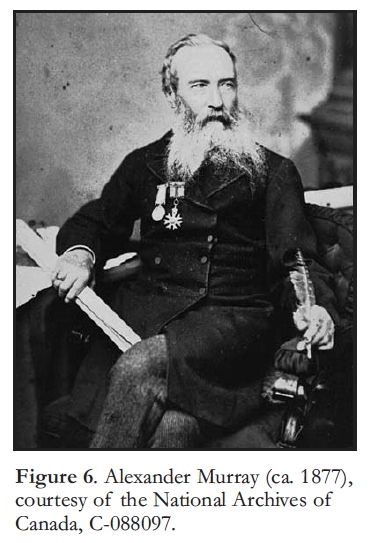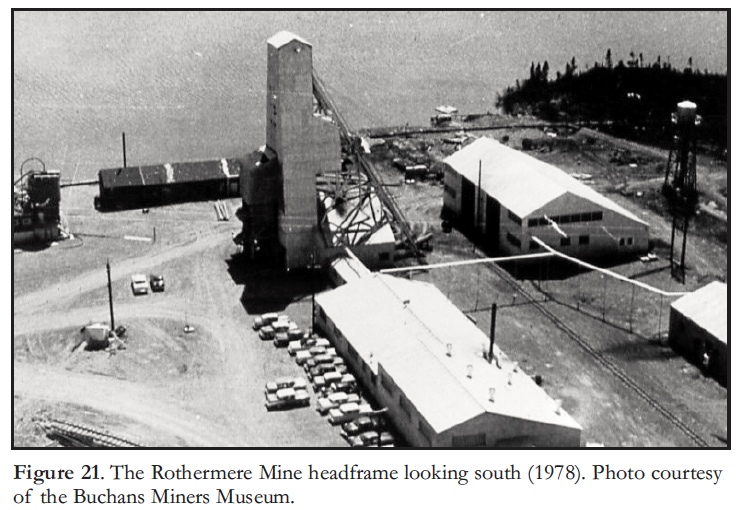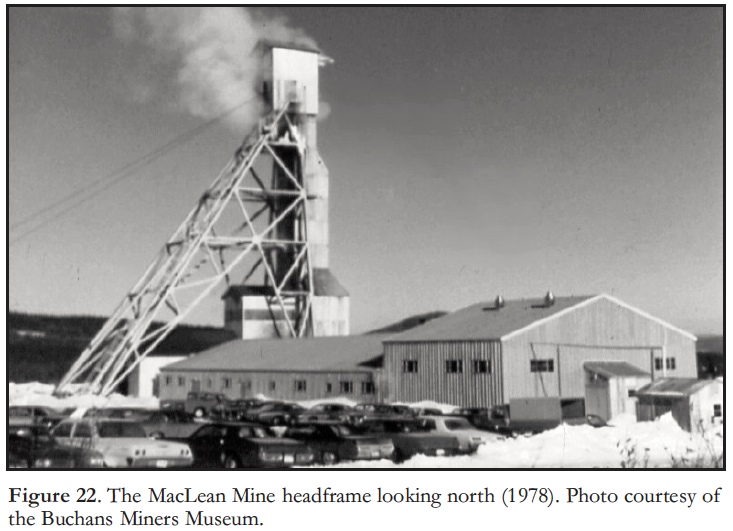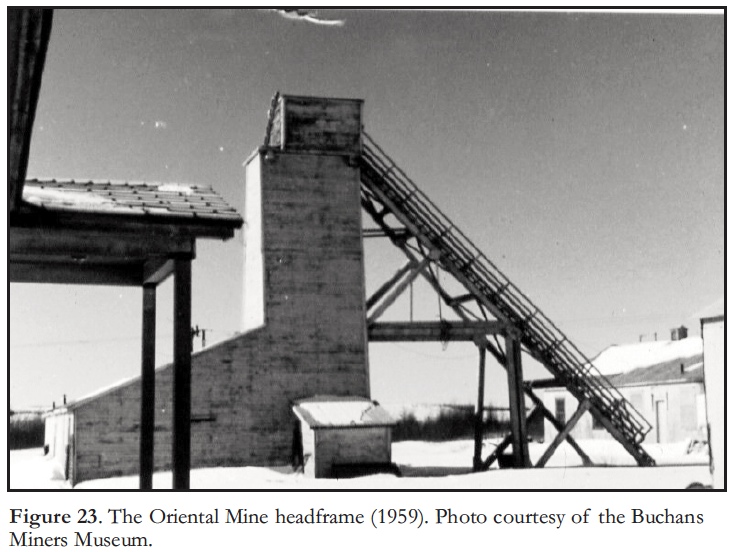Series
Great Mining Camps of Canada 3.
The History and Geology of the Buchans Mine, Newfoundland and Labrador
J. Geoffrey Thurlow16 Hammond Drive, Corner Brook, NL, Canada, A2H 2W2
geoffthurlow@gmail.com
Received May 2010, Accepted as revised September 2010
SUMMARY
The 1905 mineral discovery at Buchans River resulted from efforts by the Anglo-Newfoundland Development Company Lim ited (AND) to establish a pulp and paper industry in central Newfoundland. The discovery is attributed to Matty Mitchell, a legendary Mi’kmaq guide, who was employed by AND to assist William Canning in prospecting for sulphur on company leasehold land. The company explored the prospect and developed a small deposit, under the supervision of William Scott; however, early attempts to create a producing mine were frustrated by metallurgical difficulties and ended in 1911.Harry Guess, a director of the American Smelting and Refining Company Incorporated, (later ASARCO) had heard about the discovery, and in 1916 contacted William Scott. ASARCO conducted extensive research on samples of Buchans ore, and by 1925 had developed a successful metallurgical method of separating the fine-grained zinc, lead and copper minerals. In 1926, ASARCO entered into a 25-year agreement with AND and its subsidiary, Terra Nova Properties, to develop Buchans; Guess also made the decision to hire pioneer Swedish geo-physicist Hans Lundberg to conduct electrical prospecting on the property. In June and July of that year, Lundberg used his new geophysical technique to discover the Lucky Strike and Oriental orebodies. They would ultimately prove to be the first discoveries in North America attributed to the emerging science of electromagnetic prospecting.
A production shaft was collared at Lucky Strike in 1926 and under the supervision of J. Ward Williams, construction began the following year on a 450 tonne per day mill as well as the townsite, railroad, hydroelectric plant and other facilities. The complex began production in September 1928 and by the end of 1929, ore reserves were approximately 5.6 million tonnes. The mill was enlarged to 1100 tonnes per day in 1931; by the end of 1947, ore reserves had declined to 1.4 million tonnes. However, renewed exploration resulted in two discoveries in 1947 and 1950, named the Rothermere and MacLean orebodies, respectively.
The Buchans orebodies are part of the Middle Ordovician Buchans Group, which comprises an allochthonous sequence of bimodal, submarine volcanic rocks that were deposited in the Iapetus Ocean near the margin of Laurentia. These ore-bodies are classified as volcanogenic massive sulphide (VMS) deposits and are among the highest-grade examples of this class worldwide. From 1928 to 1984, ASARCO mined approximately 16 million tonnes from five orebodies, with an average mill head grade of 14.51% zinc, 7.56% lead, 1.33% copper, 126 g/t silver and 1.37 g/t gold. Apart from their high grade, these deposits are remarkable for the extensive development of debris-flow ores, which provided important evidence for seafloor deposition of VMS deposits in an era when this concept was not widely accepted.
SOMMAIRE
La découverte minérale de 1905 à Buchans River, découle des activités déployées par Anglo-Newfoundland Development Company Limited (AND) pour établir une industrie des pâtes et papiers dans le centre de Terre-Neuve. La découverte est attribuée à Matty Mitchell, un guide Micmac légendaire à l’emploi d’AND comme assistant de William Canning qui cherchait des indices de soufre sur des terres à bail de l'entreprise. L'entreprise a poursuivi des travaux sur le gisement et développé un petit dépôt, sous la supervision de William Scott; cependant, cette première tentative pour créer une mine n’a pas aboutie à cause de problèmes métallurgiques et en 1911, les travaux ont cessé.Harry Guess, un administrateur d’American Smelting and Refining Company Incorporated, (qui deviendra ASARCO) avait entendu parler de la découverte a contacté William Scott en 1916. ASARCO a réalisé des recherches approfondies sur les échantillons de minerai de Buchans et, en 1925 a mis au point un procédé métallurgique efficace permettant de séparer les grains fins de minéraux de zinc, plomb et cuivre. En 1926, ASARCO a conclu une entente de 25 ans avec ADN et sa filiale, Propriétés Terra Nova, pour la mise en valeur de Buchans; Guess a également décidé d'embaucher le pionnier suédois de la géophysique Hans Lundberg, afin de procéder à la prospection électrique de la propriété. En juin et juillet de cette année, Lundberg a utilisé sa nouvelle technique géophysique pour délimiter les gisements Lucky Strike et Oriental. Ce seront les toutes premières découvertes en Amérique du Nord attribuées à la nouvelle technique de prospection électromagnétique.
Un puits a été foncé à Lucky Strike en 1926 et l’année suivante, sous la supervision de J. Ward Williams on a commencé la construction d’une usine de traitement d’une capacité de 450 tonnes par jour ainsi que l’aménagement d’une ville minière, d’un chemin de fer, d’une centrale hydroélectrique et d'autres installations. Le complexe a commencé la production en Septembre 1928 et à la fin de 1929, les réserves de minerai totalisaient environ 5,6 millions de tonnes. En 1931, la capacité de l'u-sine a été portée à 1100 tonnes par jour; vers la fin de 1947, les réserves de minerai avaient diminué à 1,4 millions de tonnes. Cependant, une nouvelle campagne d’exploration a conduit à deux découvertes en 1947 et 1950, soit le gisement de Rothermere et le gisement de MacLean.
Les gisements minéralisés de Buchans font partie du Groupe de Buchans de l’Ordovicien moyen, et qui comprend une séquence allochtone bimodale de roches volcaniques sous-marines déposées dans l’océan Iapetus près de la marge de Laurentia. Ces gisements minéraux sont des dépôts de type sulfures massifs volcanogéniques (SMV) et sont parmi les exemples à plus haute teneur de ce type dans le monde. De 1928 à 1984, ASARCO a extrait environ 16 millions de tonnes de cinq gisements, avec une teneur moyenne du minerai traité de 14,51 % de zinc, de 7,56 % de plomb, de 1,33 % de cuivre, 126 g/t d’argent et 1,37 g/t d'or. Outre leur haute teneur, ces dépôts sont caractérisés par leur forte proportion de minerai en coulée de débris, ce qui a constitué un indice déterminant en faveur de l’hypothèse de dépôts de SMV sur les fonds marins, à une époque où ce concept n’était pas encore bien accepté.
INTRODUCTION
1 The Great Mining Camps of Canada series was developed to meld the history, geology and social impact of Canada’s great mining camps into single review papers aimed at a broad audience (Cathro 2006). The Buchans Mine, located near the geographic centre of the island of Newfoundland, became one of Canada’s great mines when Newfoundland became a part of Canada in 1949. At that time, it had already been producing zinc, lead, copper, gold and silver for more than 20 years. This paper traces the historical development of the mining enterprise at Buchans from the years preceding the discovery of ore to mine closure in 1984. The remarkable geology of the orebodies is summarized, as well as aspects of the socio-economic, geoscientific and technological impact of the mine.
2 Ironically, until recently, Buchans was never described as a mining ‘camp’; instead, it was more of a ‘company town’. From the outset, the existence of large mineral concessions precluded any speculative claim staking by prospectors within tens of kilometres of the town. Although isolated, Buchans was a well planned, company-built community and had amenities that many larger towns lacked. Until 1956, when the road link to the Trans-Canada Highway was completed, the only access into town was via the company-owned railway, and that access was strictly controlled. Consequently, Buchans lacked the frontier flavour and eccentric characters that attended many of the early Canadian mining camps.
3 At the time Buchans was discovered, Newfoundland was a colony of Great Britain. The bankruptcy of the Colonial Government in 1934 during the Great Depression, followed by World War II, ultimately led to the referendum of 1948, in which a majority of Newfoundlanders voted to become part of Canada. Newfoundland officially became a Canadian province on March 31, 1949.
4 Most of the historical aspects of this paper have been extracted from an article entitled Mining History of the Buchans Area (Neary 1981), which was originally published as the lead paper in Special Paper #22 of the Geological Association of Canada (Swanson et al. 1981). Because the GAC Special Paper has been long out of print and because Buchans played such an important role in the history of Canadian exploration methods and mining geology, it was felt that the spirit of Neary’s superb article should be incorporated into and republished as part of the series describing Great Mining Camps of Canada. The original historical account has been reorganized, updated to remove anachronisms and shortened to omit less relevant sections; any errors or serious omissions are the responsibility of this writer. Eric Swanson passed away in July of 2005, and George Neary passed away in August 2005.
HISTORY OF EXPLORATION AND DEVELOPMENT
Early Mining Ventures in Newfoundland
5 The earliest attempt at mining in Newfoundland occurred 20 km south of St. John’s (Fig. 1), where copper was mined for two years beginning in 1776, and then again for a few months in 1839. A copper discovery in 1857 at Tilt Cove, a small fishing hamlet in Notre Dame Bay, resulted in the opening of the Union Mine in 1864, which led to the discovery of the nearby Betts Cove and Little Bay copper mines in 1875 and 1878, respectively. The opening of the Union Mine and the establishment of the Geological Survey of Newfoundland, also in 1864, provided the impetus for a lively interest in mining enterprises. By 1880, production from mines in the Notre Dame Bay area had made Newfoundland the sixth largest copper producer in the world. However, these mines were all situated near the coastline and the mineral wealth of the interior would not be explored for another 25 years.
Figure 1. Map showing the location of the lease to the Anglo-Newfoundland Development Company, Limited, in central Newfoundland (shaded area) as well as other features referred to in the text (after Neary 1981).
Display large image of Figure 1
6 The discovery of the important Buchans zinc–lead deposits resulted from efforts to establish a lumber industry in the interior. The exploitation of the forests became a reality in the first decade of the twentieth century following the construction of a railway across the island. The Colonial Government entered into a contract with the Newfoundland Railway Company in 1880 to construct a railway from St. John’s to the copper mining area at Notre Dame Bay (Fig. 1) and construction started the following year. Subsequently, the Government decided not to run the line north from Exploits River to Halls Bay (Fig. 1), but instead extended it west to the east end of Grand Lake, then southwest to Port-aux-Basques. Sir Robert Gillespie Reid (Fig. 2) completed the construction in 1897 after the original contractor defaulted in 1883.
Figure 2. Sir Robert G. Reid (ca. 1890), from Newfoundland & Labrador Heritage [http://www.heritage.nf.ca/society/rg_reid.html].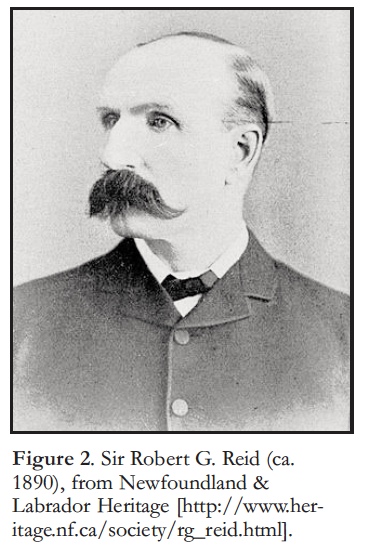
Display large image of Figure 2
7 Reid was a highly respected bridge and railroad builder who had completed several important projects in Canada. In return for completing the railroad and undertaking to operate it, he was given over 15 000 square kilometres of land across the island in fee simple (absolute title forever, without limitation or condition). The Reid interests were incorporated as the Reid Newfoundland Company Limited in 1901, which continued to operate the railway until 1923. When the operation of the railway proved unprofitable, the company turned to the development of the timber and mineral resources on their properties. The pine forest around Red Indian Lake seemed particularly attractive and Robert Reid was able to interest Lewis Miller (Fig. 3), a Scottish lumber mer chant, in developing it in 1900.
Figure 3. Lewis Miller (ca. 1900), from Millertown Museum [http://www.museevirtuel.ca/pm.php?i d=record_detail&fl=0&lg=English&ex =294].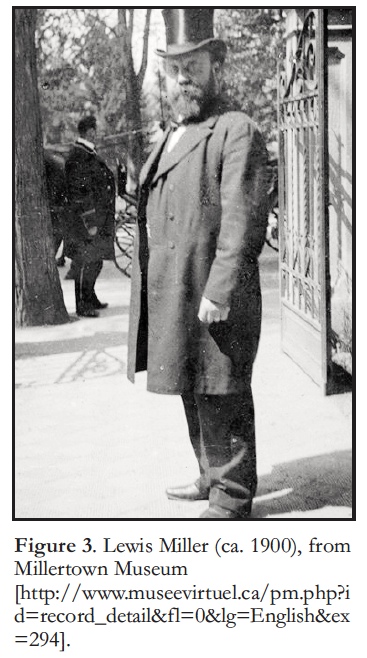
Display large image of Figure 3
8 Lewis Miller’s enterprise was large, consisting of two mills, one at Glenwood on Gander Lake and the other at Millertown on Red Indian Lake (Fig. 1). To gain access to the forest at Red Indian Lake, a 29 km branch rail line was built by Reid in 1900 from the main line at Millertown Junction (Fig. 1) to the site of the new community at Millertown. Miller brought in 60 Swedish lumbermen and their families, and a number of Scotsmen, and built the community of Millertown to accommodate them. However, the pine forest that had looked so attractive proved to be of poor quality, producing less than 50 per cent marketable lumber, and the enterprise had to be abandoned within three years.
9 Sir Robert’s eldest son, William D. Reid, and his partner Harry J. Crowe bought out Lewis Miller. They believed that the Newfound land wood was more suitable for making paper. Crowe was an extraordinarily dynamic promoter and played a major part in initiating the newsprint industry on the island. He quickly set out to enlarge the Miller holdings by purchasing sawmills then operating at Bot-wood, Norris Arm, Gambo, Gander Bay and Point Leamington. These mills were but a means to an end and were kept operating only until they had achieved their primary objective of controlling sufficient forest lands.
10 Crowe then went to London to find new investors, which led him to Alfred C. Harmsworth (Fig. 4) and his younger brother Harold S. Harmsworth (Fig. 5), later to become Lords Northcliffe and Rothermere, respectively. They were early pioneers of tabloid journalism, press barons who published the London Daily Mail newspaper and built what was then the largest periodical publishing empire in the world. They were obtaining their newsprint from Scandinavia and Finland at the time but feared that a European war would interrupt those sources. Therefore, they welcomed this opportunity to acquire a secure alternative source in Newfoundland. Mayson Beeton was dispatched to Newfoundland in 1902 to complete a preliminary investigation and begin negotiations with the Premier, Sir Robert Bond, for the development of timber lands in the Red Indian Lake watershed.
Figure 4. Alfred C. Harmsworth, Lord Northcliffe (ca. 1919), from Wikipedia [http://en.wikipedia.org/wiki/Alfred_ Harmsworth,_1st_Viscount_North-cliffe].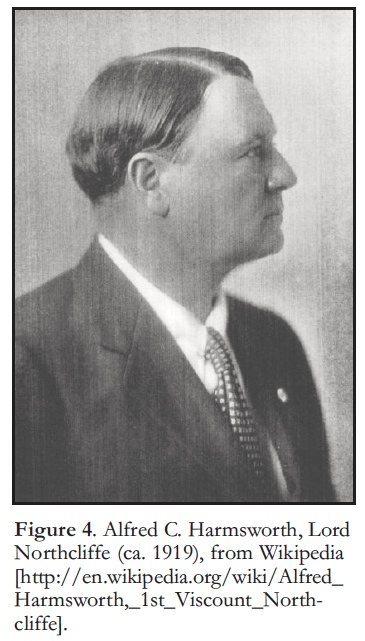
Display large image of Figure 4
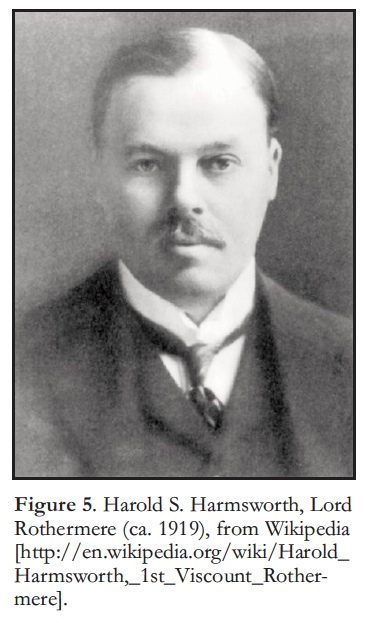
Display large image of Figure 5
11 Crowe and Reid incorporated Newfoundland Timber Estates in 1903 to hold their forest lands, while the Harmsworths incorporated the Anglo-Newfoundland Development Company Limited (AND) in January, 1905. Within a few days, the two parties signed agreements with the Newfoundland Government that were confirmed on June 15, 1905 by an Act of Parliament titled An Act to Encourage the Manufacture of Pulp & Paper in this Colony. It provided for a 99-year lease of "all the lands, and lands covered by water, situate in the districts adjoining Red Indian and Victoria Lakes in the Island of Newfoundland, which said lands are bounded or circumscribed by the height of land and include the entire area of watershed which from the height of land aforesaid drains either directly or indirectly into the Exploits River at or above a point on that river situate about 20 miles below the outlet of that river from Red Indian Lake . . .; together with, by way of grant, sale or demise, and not of exception, all timber and trees being on the said lands, and also all mines and minerals therein and thereunder." The AND Company was obligated under the terms of the 1905 Agreement to undertake a complete survey of the entire lease area (Fig. 1) within six months.
12 A St. John’s firm, Sullivan and Canning, Chemists and Surveyors, was retained to carry out the initial survey for AND. The 1905 Act had barely received royal assent from the Governor of the Colony when Michael S. Sullivan, who had worked on the engineering staff of the railway, commenced the formidable task of traversing and marking the boundaries of AND lands in the Red Indian and Victoria lakes districts, which were calculated to have an area of approximately 5200 km2.
Exploration of the Buchans Area
Early Explorers
13 Prior to the completion of the railway in 1897, mineral exploration away from the coastline was limited to major rivers. Although these rivers were generally difficult to navigate, First Nations people, the Beothucks and later the Mi’kmaq, were masters of the interior and the original explorers. The first sketch map of the Exploits River, which drains Red Indian Lake into Notre Dame Bay, was drawn in 1786 by Lieutenant John Cartwright of the Royal Navy, who had made the difficult ascent of the river to the lake (Fig. 1). In a letter to Sir Hugh Palliser, Governor of Newfoundland, Cartwright stated, "At all opportunities I cast an eye on the naked beds of the brooks, but without perceiving any indications of lead or copper that I was acquainted with; but in many places the water is strongly tinctured with iron." In the winters of 1810-11 and 1819-20, Captain David Buchan, after whom the town of Buchans was named a century later, also ascended the Exploits River to the lake.
14 In 1839-1840, J. Beete Jukes, who was employed by the Government of Newfoundland to do a geological survey of the island, commenced a survey of the Exploits River. However, he encountered great difficulties while ascending the river and was forced to return before reaching Red Indian Lake. He expressed his view of the mineral potential in the following manner: "In the interior of the country search for such things as mineral veins would be endless, their discovery must be left to chance."
15 Alexander Murray (1810-1884; Fig. 6), who was appointed as the first director of the Geological Survey of Newfoundland in 1864, would have been pleased to see the Harmsworths investing in Newfoundland. Born in Perthshire, Scotland, he had been hired in 1843 as the first assistant to Sir William Logan, founder of the Geological Survey of Canada. Murray and his assistant, James P. Howley, who succeeded him as director in 1887, commenced a program of systematic geologic mapping of the island and made two excursions into the Red Indian Lake country in 1871 and 1875. Murray was dismayed to find how difficult it was to explore the interior and believed that the fertile soil and extensive timber in the interior should be used to lure entrepreneurs who would open up the country and discover hidden mineral wealth.
Figure 6. Alexander Murray (ca. 1877), courtesy of the National Archives of Canada, C-088097.Discovery of the Buchans Deposit (1905)
16 Matty Mitchell (Fig. 7), who has been popularly credited as the original discoverer of Buchans, was born in Halls Bay into a Montagnais and Mi’kmaq family. His forefathers were traditional hunters and trappers and the wilds of the Newfound land interior were their hunting ground. They travelled easily throughout the wilderness along well-established river routes from Conne River on the south coast to St. George’s on the west coast, to Halls Bay on the north coast, and to points in between (Fig. 1). For years they had served as guides to the island’s explorers and geologists. Frank G. Speck, an authority on the Beothuck and Mi’kmaq, wrote in 1922 that the old Mitchell family held a hereditary chieftaincy, which gave them unhindered hunting privileges, including proprietary hunting and trapping rights to an area around King George IV Lake, which lies at the headwaters of Red Indian Lake and was included in the lands leased to the AND Company (Fig. 1). It is very probable that Matty had already worked for the Reid interests on railroad location surveys and in prospecting their fee simple lots. In August 1905, he was working as an assistant to William Canning, who was conducting geological studies for Sullivan and Canning on behalf of AND.
Figure 7. Matthieu Michel, better known as Matty Mitchell (ca. 1920), from the Matty Mitchell webpage [http://www.vcn.bc.ca/~fgp/welcome.htm].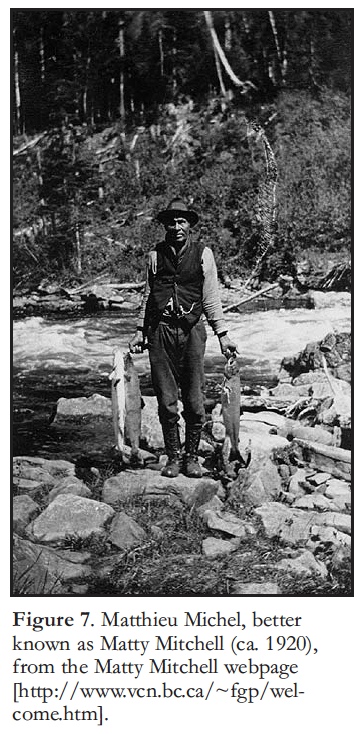
Display large image of Figure 7
17 The first reference to Matty Mitchell’s role in the discovery was contained in a Report on the Buchans River Mine by Walter Harvey Weed of the firm Weed and Probert, Geological and Mining Engineers, of New York City, dated October 1911. A subsequent report, written in 1927 by mining engineer George Frances Laycock, does not name the discoverer, but it lends weight to Weed’s reference by his statement: "... the original ore deposit which outcrops (sic) on the banks of Buchans River was discovered in 1905 by an Indian prospector employed by the Company ..."
18 Two pioneers of the Red Indian Lake country, Francis Perrier and Aubrey Goodyear, support Mitchell’s role in the discovery. Perrier, who knew Matty Mitchell, was shown the prospect in 1906 when he was in his mid-teens. He recalled that "Matty, with his son Lawrence and friend Jim Sheppard, carried out seasonal prospecting for AND during the years 1904, 1905 and 1906. This prospecting was confined mainly to rivers and brooks. Matty had no education and Jim Sheppard, who had been to school, would draw rough maps of prospecting routes and mineral locations. Matty was paid $18 a month plus his food and camping equipment. At the end of the 1906 season, he was paid a bonus of $2.50, the equivalent value of a barrel of flour, for his discovery of the Buchans River deposit in 1905."
19 Aubrey Goodyear, born in 1896, was a few years younger than Francis Perrier. As a boy of 13 or 14, he had worked for a few months at the Buchans River Mine as a stable hand, feeding and caring for the horses that hauled supplies from Red Indian Lake to the prospect and took out bulk ore samples on the return trips. He worked for AND until 1927, when he began a 33 year career as a locomotive engineer with the American Smelting and Refining Company Incorporated (ASARCO). He recalled that he had heard that Matty Mitchell, a trapper, discovered the ore in 1905 while boiling his kettle at Old Buchans (site of the original discovery on Buchans River). Mitchell apparently noticed that his fire had melted some broken rock that turned out to be rich in lead.
20 It is sad to realize that such a legendary figure as Matty Mitchell can be quickly forgotten. His life was replete with exploits as a furrier, prospector and guide. Fortunately, one of his guiding feats has been well recorded. On a harrowing 644 km trek during the winter of 1908, he guided a herd of 50 reindeer with their Laplander caretak ers from St. Anthony to Millertown (Fig. 1). Matty became sick while prospecting for gold on St. John Island, in the Strait of Belle Isle (Fig. 1), when he was about 75 years old. He died in 1922 in Corner Brook and did not live to see his discovery at Buchans River become a mine.
Initial Exploration (1905 - 1911)
21 William F. Canning, who had completed part of the mining engineering program at McGill University, was working as an assayer for Sullivan and Canning in 1905, when he was directed to conduct geological studies in conjunction with Sullivan’s survey work. When the Harmsworths acquired the mineral rights, they hoped that sulphur deposits would be found to fill the requirements of the paper making process in their new mill to be built at Grand Falls. Therefore, Canning’s first task, assisted by Matty Mitchell as a prospector and guide, was to prospect AND lands in search of sulphur or other minerals of economic interest.
22 He made the first geological examination of the Buchans River mineralization for AND in 1905. He described his search along Sandy (now Buchans) River (Fig. 8) on or about September 15, in his report dated December 22, 1905 as follows: "We first paid a visit to Sandy River, which we examined for about five miles from Red Indian Lake to a large pond from which it takes its rise. About three miles from its mouth the first indications of mineral ‘in situ’ were found. . . . About a mile above, a second out-crop of mineral was located which was found to be lead and copper in barytes gangue. We called this outcrop No. II; whilst about 150 yards above this was found, as we considered, a third outcrop of the same ore as the last mentioned or No. II outcrop. This we called outcrop No. I. Here we found lead and copper ore with barytes over a distance of 100 feet in the riverbank, separated apparently by walls of rock, so that the appearance was that of several veins. As it was not possible to examine the riverbed owing to the number of arge boulders and the depth of the water, its presence in the stream ‘in situ’ could not be ascertained. ... (Fig. 9)."
Figure 8. Map of Buchans and surroundings, circa 1980 (after Neary 1981).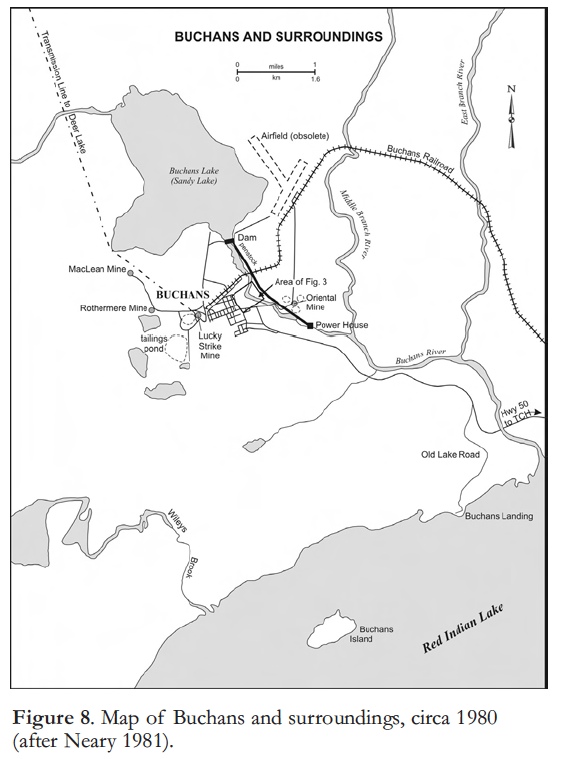
Display large image of Figure 8
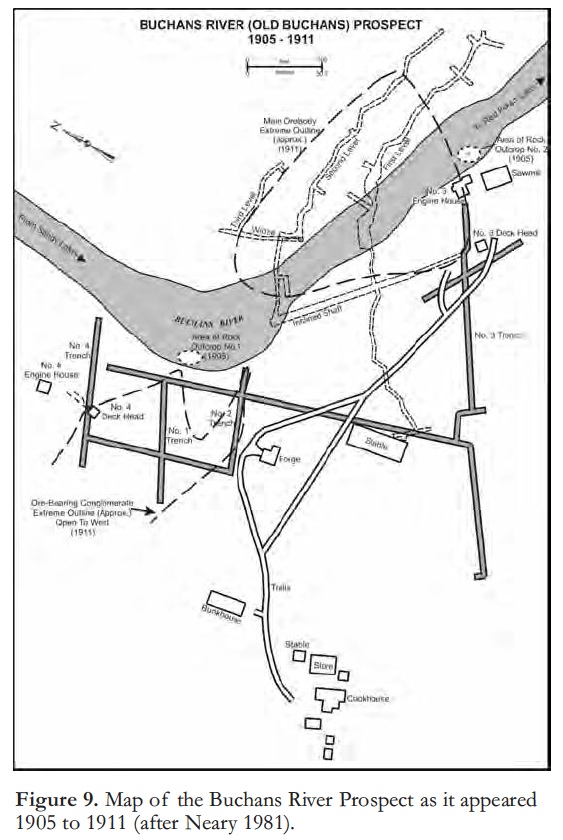
Display large image of Figure 9
23 Canning and Mitchell continued around the shores of Red Indian Lake and examined several other rivers and brooks that flowed into the lake. He was then recalled to Millertown and instructed to return to Sandy River and uncover the lead and copper showings to get more information about the mineralization. Canning reported: "... as men were not available, we could secure but one, and with our party increased now to three we left Millertown October 21st. Arriving at our destina tion, we spent some days opening up the prospect, which was done by stripping, digging pits, and trenching. The orebody was found to extend over a distance of about 140 feet, as far as uncovered, and from the direction in which it appeared to run I am of opinion now that outcrop No. II, 420 feet further (sic) down the stream, is a continuation of outcrop No. I. ...(Outcrop No. I) ... Here is an outcrop largely lead and zinc ore, with barium sulphate and a little copper pyrites. The rock over the orebody, along the whole cliff practically, is shot through with sulphides. The width of cliff carrying ore is 8 feet, measured up and down the face of the body. Samples selected from a fine body of the ore were found on assaying to give the following results:Zinc, 37.40%; Lead 20.0%; Copper 0.74%; Silver 26.4 ozs. per long ton; Gold, a fair trace. . . Analysis of samples selected from outcrop No. I on account of the presence of copper gave: Copper 4.64%; Lead 5.62%; Gold and Silver, traces; Zinc not estimated. . . (Outcrop No. II). . . . Here the vein was found to be about 40 feet wide, the center of which for at least 30 feet consists of barium sulphate, with mineral sulphides on either side. The analysis of a typical ore from this section gave:Lead 9.0%; Copper 3.60%; Silver 3.4 ozs. per long ton; Gold, fair trace; Zinc not estimated. Samples of dark coloured barium sulphate assayed for gold and silver, but found none. . . . . . From the examination of the accompanying sketch with this report it will appear that a prospect of considerable promise has been located. It remains now to prove the property. No expression of opinion is put forward to account for the disposition of the orebody. Very little information could be gathered on this point, the mineral being exposed along the face of the cliff with no well-defined wall rock visible, and is only found on one side of the river. . . . . . . We struck camp November 2nd, and travelling every day, reached Millertown Junction the 6th of November ..."
24 William Canning continued to work for AND for several years after completing the above report in 1905, residing at Millertown, where he ran an assay office until 1909.
The Buchans River Prospect (later named "Old Buchans")
25 In the summer of 1906, William Scott (Fig. 10), a civil engineer on the staff of AND in Grand Falls, made a detailed survey of the prospect (Fig. 9) and extended and sampled the trenches and pits started in 1905. Scott eventually rose through the positions of Chief Engineer, General Manager and Vice President of the Grand Falls paper mill.
Figure 10. William Scott (third from right, 1909), courtesy of the Grand Falls–Windsor Heritage Society, AND1152.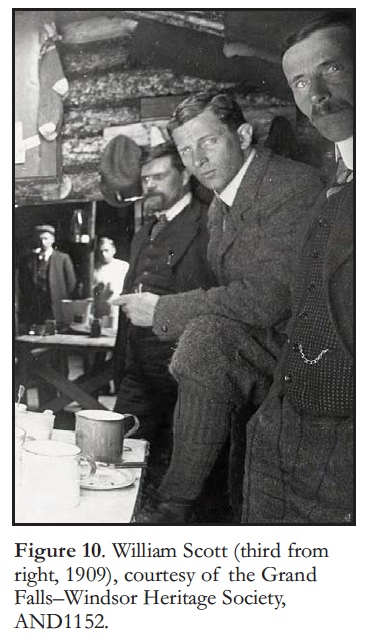
Display large image of Figure 10
26 The assays suggested that a high-grade zinc–lead deposit might be present, with good economic potential if a sufficient quantity of ore could be proven and no undue metallurgical difficulties were encountered. Before embarking on an underground exploration program, John Taylor & Son of London, England, was retained to make a thorough examination of the property and an English geologist, Col. R. C. Fielding, was hired to prepare the first geological map with Scott’s assistance. Trenching showed that the two outcrops mapped by Canning were separate mineralized areas along the west bank of Buchans River.
27 The northwestern area (Out-crop No. 1 in Fig. 9) was found to be at least 60 m long and nearly as wide. It consisted of a nearly horizontal, mineralized ‘conglomerate bed’, later recognized to be sedimentary breccia (‘transported ore’) that was deposited by gravity-driven debris flows (Thurlow and Swanson 1981; Binney 1987). A layer of glacial gravel, over 6 m thick, made it difficult to determine the thickness of the mineralization with trenches and shallow shafts. The southeastern area (Outcrop No. 2) was found to be a ‘vein’ that dipped 30° toward the northwest and extended for approximately 120 m west of the river bank. This ‘vein’ was later recognized to be part of the ‘in situ ore’ (Thurlow and Swanson 1981). Trench samples gave excellent assay values as high as 41% combined zinc, lead and copper, and consequently, an inclined shaft was recommended.
28 Shaft sinking began in 1907 when Scott hired Daniel McCuish as mine foreman, along with a few Cornish miners and a number of Newfoundlanders who came mainly from the copper mines around Notre Dame Bay. McCuish, who had come to Newfoundland from Nova Scotia and was called ‘captain’ in the Cornish tradition, had lost an arm in a mining accident while working at Pilley’s Island (Fig. 1) and earned a reputation in Newfoundland mining circles as an expert miner and a tough but fair-minded boss. His aggressive demeanour was accentuated by his habit of banging his homemade arm loudly against the nearest solid object when he wished to emphasize his point.
29 The inclined shaft, which did not follow the exact dip of the deposit, was sunk a slope distance of 78 m (a vertical depth of 41 m). It started in massive sulphides but entered barren wallrock after about 30 m. Horizontal drifts were driven along the strike of the vein at slope depths of 46 m and 76 m and these encountered massive sulphides east of the shaft (Fig. 9).
30 The vein was further developed from the second level with an inclined winze (internal shaft) 30 m deep. The massive sulphides were found to pinch out about 5.5 m above the bottom of this winze, at a depth of about 53 m below the surface. At a few tens of centimetres below the point where the ore pinched out, a third level was established and driven some 37 m to the east but no sulphides were encountered. Short cross cuts were driven on the first and second levels to probe the thickness of the deposit. Within a year, about 518 m of development work had been com pleted and two massive sulphide deposits had been defined. One part was the tabular, flat-lying lens of mineralized conglomerate, open to the west, whereas the other was the moderately dipping vein.
31 In October 1908, AND assigned its mineral rights to the Buchans River prospect, which it had obtained under the Pulp & Paper Act of 1905, to Terra Nova Properties Limited (TNP). This was a new company incorporated in England, in which AND owned a 90 percent interest.
32 Scott surveyed and systematically sampled the mine workings while Col. Fielding carried out detailed geological and mineralogical studies. From 1908 to 1910, many samples were sent to the United States and England for detailed analysis, and bulk samples of the ore were sent to various metallurgical testing companies in the USA, including the Minerals Separation Company. Despite exhaustive test ing, the problem of separating the constituent metals into marketable concentrates remained unsolved and it became increasingly evident that the metallurgical difficulties in treating this complex ore would indefinitely postpone the chance of commercial success.
33 George Francis Laycock (Fig. 11), an English mining engineer, assisted Fielding in 1909 and replaced him in 1910, beginning an association with TNP and the Buchans mining district that would last almost 60 years. He turned his attention toward Norway and Sweden, hoping that the solution to the metallurgical problem might be direct reduction of the raw ore by electric smelting. In the summer of 1910, he bulk sampled two adjacent stopes on the first level of the mine (Fig. 9) and shipped a total of 900 tonnes to Sweden. The ore was hoisted to surface, loaded aboard wagons and pulled with horses for 8 km to the steamer landing at Red Indian Lake. It was then transported by motor boat 19 km to Millertown aboard a specially built scow capable of carrying 90 tonnes (i.e. ten loads were necessary). A donkey engine was used on the wharf at Millertown to hoist the ore aboard railway flatcars for shipment to the port of Botwood, where it was loaded on a deep-sea ship. A report by Norse Power and Smelting Syndicate Limited indicated that the ore could be treated successfully and perhaps profitably by electric smelting, but Laycock was doubtless disappointed by the high transportation costs and smelter penalties.
Figure 11. George F. Laycock (1957) with inset (ca. 1910), courtesy of the Grand Falls–Windsor Heritage Society, AND0958-1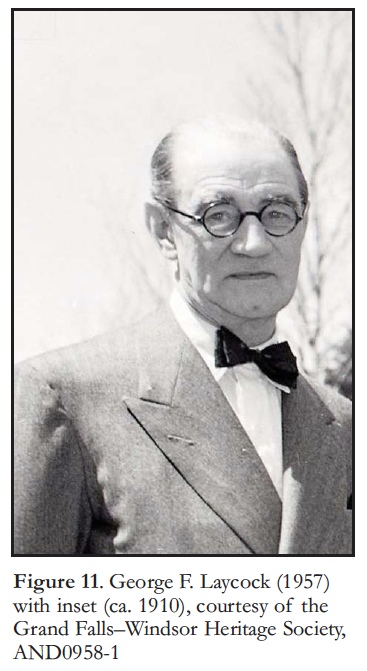
Display large image of Figure 11
34 The final chapter in the early efforts to create a profitable mine at Buchans River prospect was contained in a 1911 report by W.H. Weed, addressed to Mayson M. Beeton, General Manager of AND’s paper mill at Grand Falls. Weed made a careful evaluation of the developed orebody as well as a more general examination of the nearby surface exposures of the ‘conglomerate’ deposit. The workings were re-sampled, the boundaries of the deposit determined and sections drawn to enable a careful calculation of tonnage and grade. Weed estimated that the lens contained approximately 85 000 tonnes of sulphides with a calculated average grade of 20.38% zinc, 8.14% lead, 2.36% copper, 230 g/t silver, and about 4.2 g/t gold (valued at $2.72 per ton, with gold worth about $20.00 per oz.). He stated that the assays, although variable, indicated a good grade of shipping ore and concluded that the known deposits could be mined at a profit if the Norse Power and Smelting Syndicate investigation was valid. The tonnage, however, was too small to justify the capital cost of extending the railroad from Millertown, and even if the rail line was only built from the mine to the lakeshore (and the ore transported across the lake on barges), the profit margin would be too small. Concluding that the property warranted additional drilling, he recommended that a line of holes should be drilled along the east bank of the river, and another set of holes west of the shaft (No. 3 Deck Head in Fig. 9). However, TNP rejected his recommendations and the boilers were shut down, the pumps were stopped, and the mine was flooded and abandoned in 1911.
Buchans Becomes a Mine (1916 – 1931)
35 Harry A. Guess (Fig. 12), a Hartington, Ontario native, graduated from Queens University’s School of Mining in 1895 at age 20, and after six years of working at mines in British Columbia and Ontario, he joined the ASARCO in 1901, eventually becoming Vice President in charge of the Mining Department. On July 13, 1916, he wrote from his New York Office to William Scott of AND as follows: "Some friends of mine, familiar with Newfoundland, were recently telling me that your Company, Terra Nova Properties Limited, had a large body of good grade though complex ore opened up, but now idle, as I recall, at Buchans River Mine sort upon which we could take a long term lease on terms that would be mutually satisfactory. Wish you would let me know about this at your convenience."
Figure 12. Harry A. Guess (ca. 1928), courtesy of granddaughter Alison G. Fitton.
Display large image of Figure 12
36 Scott replied from his office in Grand Falls by return mail, inviting Guess to discuss a lease directly with the TNP head office in London. Thus began a business relationship between the English newspaper barons and tycoons of the American copper industry that would bring great rewards to both parties.
37 ASARCO had been formed in 1899 through the consolidation of a large number of smelting and refining companies. In 1901, the powerful Guggenheim family, led by Daniel Guggenheim [http://encyclopedia.jrank.org/articles/pages/6261/Guggenheim-Daniel.html], acquired sufficient company shares to gain controlling interest (hostile takeover), creating an integrated mining, smelting and refining company that produced copper, lead, zinc, silver and a host of by-product metals. The Guggenheims, using their commercial acumen, guided the company to phenomenal growth in the ensuing years. According to Marcosson (1949), the Guggenheims developed ASARCO from a firm with gross annual revenues of $82 million to $390 million, while profits grew from $2.9 million to $27 million per year between 1902 and 1918.
38 ASARCO maintained the necessary facilities and skilled personnel for on-going investigations of metal-lurgical processes to enhance the extraction of metals from ores and to perfect its smelting and refining techniques. ASARCO carried out its first experimental work on the complex Buchans ore at its ore testing facility in the Tri-State Lead–Zinc District at Flat River, Missouri. Guess asked AND to send approximately 10 kg of Buchans ore to this facility, operated by ASARCO’s subsidiary Federal Mining and Smelting Co., to determine if separate lead and zinc concentrates of commercial grade could be produced. Incidentally, Guess was also Vice President and Managing Director of this company. However, the complexity of the ore soon became apparent and, despite exhaustive testing using traditional jigging methods and fine grinding, the best lead concentrate grade that was achieved was only 9%.
39 When ASARCO began to test the Buchans ore in 1916, the art of froth flotation had been around for about 15 years (Dewitt 1940). Flotation is a process of ore concentration involving several steps:
- The ore is crushed to liberate the mineral particles from the accompanying waste rock (gangue);
- The crushed ore is suspended in a mixture of water and suitable chemical reagents within a tank (flotation cell), which has air injected at the bottom while the entire mixture is agitated; and
- Mineral particles adhere to the rising bubbles in the mixture and are skimmed off at the top of the flotation cell.
The concentrate of mineral particles is then de-watered for shipping or subjected to further processing to enhance the grade of the concentrate. At that time, however, froth flotation was only being used to separate sulphide minerals from gangue minerals because most of the chemical reagents required to separate individual sulphide minerals were not yet known. Hence, it was only useful with simple ores of copper, zinc, or lead in which one of these metals was present to the exclusion of all others, or ores in which other metals were only present in negligible amounts. Sphalerite had proven to be a particularly difficult mineral to deal with and was generally regarded as a nuisance by metallurgists at the lead and copper smelters, where it routinely incurred a penalty rather than a credit.
40 According to Dewitt (1940), froth flotation advanced to allow separation of individual sulphide minerals between 1912 and 1924, as indicated by the following: "In 1912 Lowry and Greenway discovered and patented the use of bichromates as a depressant in the flotation of galena. … In 1913 Bradford working with the accumulated tailings and slimes at Broken Hill, Australia, discovered that the addition of copper sulphate increases the floatability of sphalerite. …Perkin in 1921 introduced the use of very slightly soluble organic flotation reagents containing trivalent nitrogen, divalent sulphur, and other organic compounds. In 1924 Keller, working for the Minerals Separation Company, patented the use of less than one per cent of a soluble organic compound, particularly the xanthates, as a mineral flotation reagent…The work of Perkin and Keller is particularly significant in that it marks the point at which mineral flotation became a chemical science."
41 As a result, ASARCO finally achieved a satisfactory commercial separation of the lead and zinc minerals in the Buchans ore in January 1925. The difficult and complex Buchans sulphides could now be milled to produce separate marketable concentrates of lead and zinc. The initiative and determination of H. A. Guess had finally been rewarded. Flushed with this success, he wasted no time in pursuing an agreement with the mine owners to jointly mine the deposit and pursue new discoveries.
42 Mr. G.F. Laycock, who had shut the mine down in 1911 after many fruitless attempts to prove its viability, was again working at Grand Falls. When he heard about ASARCO’s metallurgical success, he booked passage on the first ship sailing from St. John’s to New York and met with Guess on June 19, 1925 to negotiate an agree -ment between their companies. Anglo-Newfoundland, through its subsidiary TNP, was the undisputed owner of the mining property and of the surrounding mineral rights for many kilometres. ASARCO possessed the technical knowledge and experience required to mine, mill and market the ore and to apply the best exploration techniques in the search for additional deposits.
43 The plan proposed by Guess was a 40 year contract under which ASARCO would have exclusive control and management of operations, while profits, after reimbursement of equipment costs, would be divided on a 50:50 basis. ASARCO would develop and equip the property and expend not less than $30 000 in the first year, and not less than $50 000 in the second and each succeeding year, until the mine was running profitably. Before deciding to go ahead with the contract, ASARCO would be allowed 120 days to investigate and sample the property.
44 It remained for Laycock to obtain the approval of AND but he left New York confident that his mine would soon be reopened. Many cables were exchanged between Grand Falls and London over the next few weeks to clarify all matters. The company requested that the sum of $100 000, representing the amount already expended by AND in develop ing the mine, be reimbursed before splitting profits. They also requested that Gov -ernment royalties amounting to 5% of net profits be deducted before division of profits to the contracting parties. These modifications were agreed to by Guess in a cable from Peru. Laycock immediately began preparation for the examination by ASARCO.
45 On October 15, 1925, mining engineer J.L. Baragwanath became the first ASARCO representative to visit the site. He re-sampled the ‘vein’ and ‘conglomerate’ deposits, conducted a preliminary power survey of Buchans River and investigated the economics of putting the mine into operation. He concluded that the tonnage in the Buchans mine was suffi cient to reimburse his company for initial capital expenditures, and to yield a profit over a period of two to three years. He believed that there was a fair chance of locating either a continuation of the known deposit or another similar lens and that the ‘conglomerate’ deposit might develop into an orebody of considera ble importance. He recommended to Guess that the Newfoundland Government be approached for permission to import machinery and construction materials duty free and, if such a concession could be secured, he further recommended that ASARCO enter into a formal agreement with AND and its subsidiary TNP. The formal agreement was signed on March 18, 1926 with only one notable change: the length of the agreement was reduced from 40 to 25 years. Possibly by way of a trade-off, a new clause was added that would prove to be of key importance to ASARCO. Its area of interest was extended to include any new mines found within a radius of 32 km from the Buchans River deposit.
Discovery of the Main Orebodies in 1926
46 While the agreement was being ratified, Guess began to design a new shaft and selected a superintendent, J. Ward Williams (Fig. 13), who arrived with ten men and supplies in May 1926 to oversee exploration and make preparations for construction. All his previous assignments had been in southern climates so he was not accustomed to the Newfoundland environment.
Figure 13. Part of the Buchans crew (ca 1928): J. Ward Williams (centre, seated in doorway), Hans Lundberg (right), George Gilchrist (top left; see also Fig. 14), and two unknown persons. Photo courtesy of Paul O’Brien, Buchans Miners Museum.
Display large image of Figure 13
47 Aware that the success of the project depended on increasing the ore reserves, Guess also commissioned Hans T. Lund berg (Fig. 13) to do an electrical geophysical survey on part of the property. Lundberg was a graduate of the Royal Technical Institute of Stock holm and a former Professor there; he had pioneered electrical prospecting in Sweden before moving to the United States in 1923 to conduct surveys for the Illinois Zinc Company. Guess knew of Lundberg because he had done surveys previously for ASARCO, and its subsidiary Federal Mining and Smelting, on properties in Idaho and British Columbia, respectively. In fact, the 1925 annual report of the British Columbia Minister of Mines (Galloway 1926) contains a concise description of ‘electrical prospecting’ being done by Lundberg and his Swedish Electrical Prospecting Company, on a property near the Sullivan Mine, for Porcupine Goldfields Development and Finance Company, a British firm in partnership with Federal.
48 Lundberg and his assistant, Borje Hjortsberg-Nordlund, arrived at Buchans River early in June with explicit instructions from Guess to survey an area of approximately 260 ha (one square mile) centred on the old mine. The first square area surveyed was west of the proposed mine. The survey method consisted of laying two electrodes (cables) on the ground, the first one in a north–south direction over the deposit and the second one parallel to the first and about 914 m to the west. The electrical conductivity of the ground between the two lines was determined by supplying a current between the two electrodes and tracing equipotential lines using two movable probes connected to a telephone receiver. The results disclosed that a conductive zone was present in the first square near the west electrode. That electrode was then laid out in the same orientation to the east of the mine, where another strong conductor was detected in the eastern part of the second square. Lundberg then turned his attention to the conducting zone identified west of the mine and laid out a smaller square to complete the area that Guess had requested. Another high conductivity anomaly was found near the western limit of the third square.
49 Lundberg’s survey results in the vicinity of the mine site exhibited good correlation with known mineralization and strengthened Williams’ confidence in electrical prospecting. Therefore, he authorized Lundberg to continue his work on a new square, not at Wiley’s Brook as instructed by Guess, but immediately west of the third one, where the results indicated a continuation of the highly anomalous zone from square three. Williams moved all his men from the Buchans River development work to trench this anomaly. Near the eastern boundary of the fourth square, the trenches exposed scattered lead–zinc mineralization that was named the ‘Black Fly’ zone. Trenching approximately 90 m west of Black Fly revealed massive lead–zinc mineralization on July 14.
50 Williams informed his superior by night letter, as follows:"Stripping strong lead zinc orebody five thousand feet west. Indications point to it being larger than Main mine, stop. Conglomerate shaft crosscut north cut vein ten feet wide, stop. Diamond drill hole B finished - no ore - now completing hole C, stop. Suggest postpone hole A and move to vein indication two thousand feet east - telegraph me instructions on this, stop. Believe successful outcome of enterprise assured - suggest early visit." This discovery was so exciting that even the normally uncompromising Guess overlooked his superintendent’s deviation from instructions.
51 Hans Lundberg (1928) described the discovery as follows:"Although this was the beginning of July there still were patches of snow here and there on the big bog to the west. Because of the wetness underfoot, the muggy atmosphere, and thick swarms of black flies which made it difficult to see the pickets through the telescope, work was almost unbearable. But our reward was to come soon. While finishing the survey of the anomaly a trench near the east electrode had disclosed promising lead-zinc mineralization. This location was ap propriately named Black Fly. Then we searched for a favourable place to reach bedrock on the major indica tion in the centre of the square. The area here was flat and even, like the bottom of a dried-out lake, and appeared easy to get through. Just below the surface bright yellow and red clay with a few boulders of lead-zinc carbonate was encountered. The bedrock, about 2 or 3 feet down, was massive lead-zinc mineralization. Throughout the night my assistant and I kept on digging, sometimes with our bare hands, convinced that our indication was going to make mining history by the discovery of this large lead-zinc deposit. During the night my assistant, Hjortzberg-Nordlund, said in his broken English ‘This is sure a lucky find.’ Williams corrected him, ‘not a lucky find, but a lucky strike.’ The name Lucky Strike has remained with the mine ever since."
52 The Williams–Lundberg success story was not finished. Once Williams put his crew to work opening up the Lucky Strike ore, he moved his only diamond drill to the conductor east of the mine, which he had named ‘Oriental’ Zone. On July 23, Hole No. 1 intersected 2.1 m of ore at a depth of 32 m. On August 7, a second hole, 31 m to the north intersected 16.8 m of ore similar to that encountered at Lucky Strike. Williams sent the good news via the usual night letter to New York. Thus within the space of 80 days, two valuable hidden orebodies had been located in what was previously unexplored wilderness.
53 Preliminary plans were being made in late July to locate a mill near the Buchans River deposit, to which the ore from Lucky Strike and Oriental would be trammed to take advantage of the natural grade. Guess was anxious to confirm that sufficient ore was present at Lucky Strike to enable his engineers to proceed with a mining plan and a mill design, and to get a production shaft collared before winter. By August 3, Guess was able to send a cable to Laycock requesting him to proceed as quickly as possible with the con struction of a dam on the Buchans River, at ASARCO’s expense, for the purpose of developing hydro power.
54 By August 25, a preliminary development shaft had been sunk 15.8 m in ore, and a second diamond drill rig had arrived and was being set up at Lucky Strike. A direct route was cut through the bush between this shaft and Buchans River, approximately 1200 m to the east. This trail later became the Main Street of the Town of Buchans.
55 The downward extension of the Lucky Strike orebody was verified by diamond drill hole 10, which was started on September 29. After penetrating 1.8 m of overburden, this hole intersected 36.3 m of massive sulphides, which led to the decision to locate all production activities at Lucky Strike. The development work at the Buchans River Mine ceased. By October 12, Williams had completed another vertical hole that cut 48.8 m of ore. In early November, horizontal drilling from the upper level of the development shaft cut 93.6 m and 42.7 m of excellent ore in holes 15 and 17, respectively. The decision was made in October to design a mill with a rated capacity of approximately 450 tonnes per day and to locate it near Lucky Strike. On November 15, less than six months from the time he arrived at the prospect, Williams collared the Lucky Strike shaft, which ultimately handled all the production from the Buchans orebodies.
56 Within a short six month period, the small, marginally economic Buchans River deposit that Williams had come to mine was completely overshadowed by the new discoveries. The Lucky Strike orebody was sufficiently explored by the end of 1926 to calculate an estimated reserve of some 2.7 million tonnes of high-grade ore, while the size of the Oriental orebody was still un known. It was already clear that ASARCO was going to be a corporate citizen in Newfoundland for a long time, so the company set about establishing its organization there on a firm footing. A new subsidiary, Buchans Mining Company Limited, with its registered office in St. John’s, was formed to explore and operate the Buchans property. The five directors were Harry Adelbert Guess, Francis Herbert Brownell, Roger William Straus, and John Clinton Emison, all of New York, and William R. Howley, a St. John’s lawyer.
57 A new agreement was also prepared to incorporate TNP as a Newfoundland corporation, rather than British, and to make two important changes in the original agreement between the two companies in light of the vastly improved prospects for the joint venture. First, the area of influence of ASARCO’s mining rights around the Buchans River Mine was increased from 32 to 48 km, and second, the duration of the agreement was extended from 25 to 50 years from March 18, 1926. The new agreement was signed on December 12, 1928. The TNP would effectively administer the in terests of AND at Buchans, with G.F. Laycock serving as Vice-President of both companies and rep resenting Buchans Mining Company (BMC) in negotiations with the Newfoundland Government.
Mine Development
58 Williams spent the winter of 1926-27 getting ready for mine construction the following spring. Freight was hauled on a winter road using a gasoline-powered Holt tractor from Millertown to Buchans Landing (Fig. 8), where a dock, long enough to accommodate two flat cars, was built to unload the boats that would haul freight during the summer of 1927. Most of the freight was delivered on a temporary light rail line between Millertown Junction and Millertown (Fig. 1), then across Red Indian Lake by scow to Buchans Landing, and lastly from the lake to the site by Linn tractor, via the trail that was cut for William Scott in 1907.
59 The railroad was essential to speed up the movement of incoming mine and mill machinery as well as heavy pieces of construction equipment. Major Harry Windeler, chief engineer with AND, was directly in charge of these projects. A preliminary location survey for the railroad had been carried out by M.S. Sullivan in 1908. The final route was surveyed in the fall of 1926 by a party led by Guy Harvey of Windeler’s staff. In February of 1927, 80 men were working on the line and by June of that year 600 men were employed laying rail and building bridges. The rail line was completed and in service by the end of October.
60 Although excavation of the mill foundations had to be done with pick and shovel, the first pour of concrete was made for the crusher foundation in early May. The pace of work accelerated as the crew engaged in mine and mill construction grew from 400 to more than 900 between May and December. By the end of the year concrete foundations had been completed for all the principal plant buildings, including the massive concrete foundations for a large concentrate storage building. Approximately 2300 m3 of concrete were poured in the first construction season.
61 The concrete workers were followed by the steel erection crews. The steel headframe for the Lucky Strike shaft was built around the original wooden structure, while shaft sinking continued. Before leaving Newfoundland, the crew moved to Bot-wood and erected a concentrate storage shed there.
62 The tasks of building the dam and penstock for the hydroelectric plant, the 35 km of railroad into the mining camp, and the shipping facilities at the Port of Botwood were handled by AND. The 2500 HP hydroelectric system consisted of a dam across the Buchans River at Sandy Lake, a 1.8 m diameter steel penstock approximately 1.6 km long, and a downstream, power-generating plant (Fig. 8). The rock-filled timber crib dam was started late in 1926 and was completed in the late summer of 1927. The first electric power was generated in the second week of January, 1928. At Botwood, the existing coal wharf was extended and strengthened.
63 George G. Gilchrist (Figs. 13, 14), a 1920 graduate of UBC, had been working as a mining engineer for ASARCO at the Premier Gold Mine in British Columbia, before going to Buchans in late 1926. He was put in charge of planning and engineering of the mine development work, leaving Williams to concentrate on the many problems associated with the erection of the mill, plant and townsite. Mine development kept pace with surface construction. By the end of 1927, the main shaft was down approximately 96 m and driving of the haulage ways beneath the Lucky Strike orebody was well underway (Fig. 15).
Figure 14. George C. Gilchrist (1928) with inset (1920), courtesy of daughter Marjorie G. Sheridan.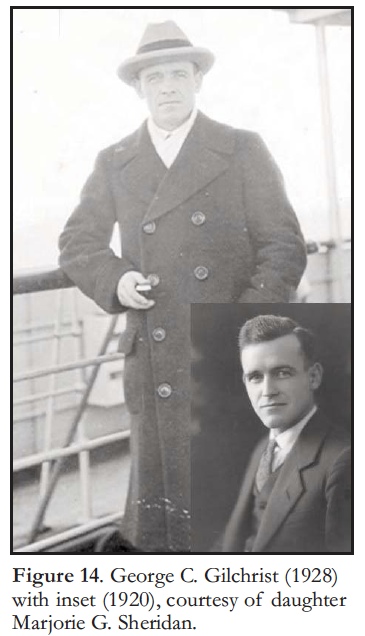
Display large image of Figure 14
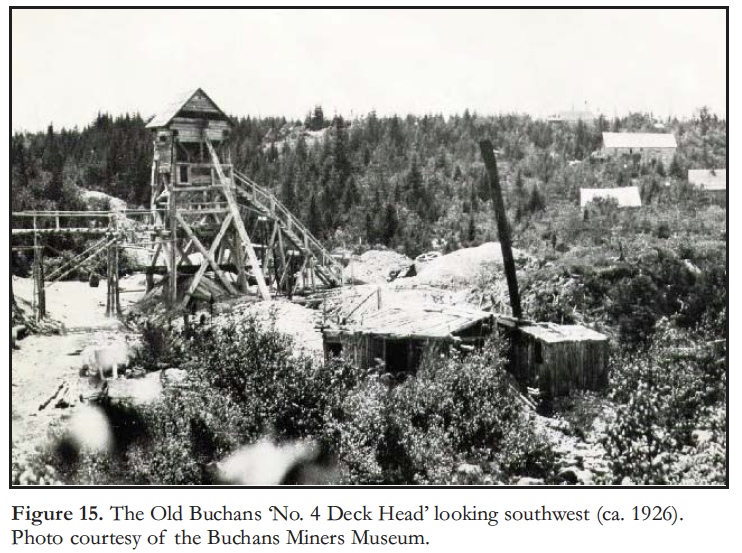
Display large image of Figure 15
64 On July 27 of 1928, Williams wired Guess to inform him that the mill would be ready for operation on August 6, but misfortune struck three days later. At 8:30 in the morning, the storage dam at Sandy Lake (Fig. 8) burst and the lake water, which had been raised 4.6 m at the dam, was unleashed. The flood crest swept its way down Buchans River, punching a hole in the forebay dam and knocking out two sections of the high timber trestle that carried the railway across the river. The bunkhouse, which accommodated 200 men, was devastated and carried away by the torrent, but fortunately, most of the men were on shift at the time. The others had barely enough time to scramble to higher ground, where most were marooned before being pulled to safety through the water with ropes. One man was reportedly washed down the river but was found on an island and safely taken ashore. Miraculously, there was no loss of life. The windows and walls of the powerhouse were severely damaged and the electrical equipment was swept away. However, the turbine and the generator survived.
65 The loss of the dam and resulting destruction along the river were a serious setback to the project. The failure was attributed to the river undermining the rock-filled timber cribs that had been positioned on a soft bottom. The loss of hydroelectric power and the water required to generate it, ruined all plans for a mill startup by August 6. Undaunted, Williams and Laycock marshalled all available forces to the task of repairing the damage. As the result of a mighty effort through the month of August, essential repairs were completed and a sufficient head of water was backed up to feed the power plant. The first ore was started through the mill on September 1, 1928 and the first metal concentrates were produced on September 6.
66 During the first four months of production, from September to December of 1928, inclusive, approximately 31 000 tonnes of ore were milled and 13 000 tonnes of metal concentrates were produced. The richness of the ore lived up to expectations – the average grade was calculated at 0.05 ounces (1.6 g/t) gold, 5.5 ounces (171.1 g/t) silver, 0.7% copper, 11.4% lead and 20% zinc. Metal prices at the time were approximately $20 per ounce for gold, $0.55 per ounce for silver, $0.16 per pound ($0.35/kg) for copper, $0.05 per pound ($0.11/kg) for lead and $0.06 per pound ($0.13/kg) for zinc. The net smelter value of the ore FOB the Buchans mill was $10.12 per tonne. The total operating cost per ton of ore milled was $4.63 per tonne. Mill operators were being paid $3.25 to $3.75 per shift of eight hours and miners $0.36 per hour. The operating profit was $5.49 per tonne. Gross profit for 1928 production amounted to $169 000 before any amortization of invested capital, payment of royalty or division of profits with TNP.
67 The arrangements for the sale and delivery of concentrates were handled by ASARCO and the first sales contracts were to European smelters. Metallgesellschaft A.G. of Germany agreed to purchase all the lead concentrates as well as 50% of the zinc concentrates. The remaining 50% was sold to La Société Des Minerais of Belgium. The first trainload of concentrates left Buchans for the Port of Bot-wood on October 9, 1928, and consisted of approximately 2200 tonnes of lead concentrates destined for a smelter at Hamburg, Germany, and 4200 tonnes of zinc concentrates for a smelter at Avonmouth, England.
68 The departure of the Swedish vessel Kiruna almost became a disaster on her second day outward bound from Botwood, as she was ploughing through rough seas well out of sight of land. A distress message was received from the vessel via the AND wireless station at Botwood and was relayed by land line to the Company office at Grand Falls. The master’s SOS call stated tersely: "lead cargo melted (liquefied) ship half capsized." Two railway steamers in the general vicinity, the Prospero and the Kyle, were instructed to proceed to the Kiruna’s position and render all assistance possible. Captain Ljungberg, the master of the Kiruna, had managed to get the ship turned around and was trying to get back to port. His second message an hour later stated: "ship 35 degrees list trying come back can you do anything for us telegraph pilot lookout please answer." The S.S. Kyle reached the stricken ship over six hours after the first SOS. Through good seamanship and a measure of good luck the Kiruna, accompanied by the Kyle, made it back to the Port of Botwood in the middle of the night. The captain anchored his ship but, perceiving that the vessel was slowly sinking, beached her in order to save the ship and cargo.
69 The concentrates on board the Kiruna were unloaded into lighters and returned to storage near the concentrate storage shed at Botwood. The ship was refloated and brought alongside the ore-wharf and put into sea-going order again. When the captain stated flatly that the concen trates were unsafe for shipment and steadfastly refused to reload the Kiruna, it sailed from Botwood on January 1, 1929 with no cargo aboard. In the mean time, a second vessel, the Agga, arrived at Bot-wood on December 31. The master examined the concentrates and also refused to load, sailing out of Bot-wood on the same day as the Kiruna. This ruined all chances of getting the product to market during the 1928 shipping season because Arctic ice floes normally closed down the port of Botwood in January and prevented reopening until the end of May. On June 1, 1929, the steamer Lulea sailed from Botwood with 6800 tonnes of concentrates and delivered the cargo safely to smelters at Avonmouth, England and Hamburg, Germany. The stigma aroused by the Kiruna incident faded away and there followed, over the life of the mine, many hundreds of successful trans-Atlantic voyages with no comparable occurrence.
70 The problem with the Kiruna shipment occurred because the concentrate contained too much moisture. The cargo appeared to be in a relatively dry granular state but it contained sufficient moisture to become fluid under the stimulus of compaction and vibration. The lead and zinc concentrates loaded aboard the Kiruna in 1928 con -tained average moistures of 9.7% and 10%, respectively. During later years, the transportable moisture limit of Buchans lead and zinc concentrates was 7.2% and 9.4% respectively.
Surviving the Great Depression
71 Buchans had the huge misfortune of beginning production just before the start of the Great Depression. Metal prices began falling at the end of 1929 and had dropped by half by mid 1930 compared to the fall of 1928, when production began. The tumble continued until lead and zinc prices bottomed in February 1933 at a third of their 1928 values, i.e. $0.016/lb ($0.035/kg) for lead, $0.02/lb ($0.044/kg) for zinc, and $0.25/oz for silver, less than half of its previous value. For Buchans, the situation was further aggravated because its concentrates were marketed under London sterling quotations via European smelter contracts, and the British Pound fell from $4.85 to $3.30 in terms of U.S. dollars during the period from 1928 to 1933. The net smelter value of Buchans ore rose from $10.12 per tonne at the outset of production, to an average value of $12.81 in 1929, before falling to $5.53 in 1930, $3.58 in 1931 and $3.01 in 1932. Since the cost to mine and mill a ton of ore had been $5.59 per tonne in 1929, it became increasingly obvious that the production cost would have to drop if the mine were to remain profitable.
72 By 1929, drilling had defined the limits of the Oriental deposit and total proven ore reserves had increased to more than 5.4 million tonnes, which represented nearly 40 years of life at existing mill capacity. To reduce the unit cost of production to match the declining value of the ore, it was essential to double the milling rate to approximately 1100 tonnes per day. Guess, Laycock and Williams had given a great deal of study to enlarging the hydroelectric plant to support mill expansion, but ultimately decided that the best option was to purchase power from the International Power and Paper Company (IPP), which had built a large hydroelectric installation a few years earlier at Deer Lake, 77 km away (Fig. 1). A 20-year contract was signed in May 1930, under which IPP built the power line at BMC’s expense.
73 In February 1930, P.W. George replaced Ward Williams as mine manager. George had previously held senior positions at ASARCO opera tions in Idaho and Missouri and was an expert in coordinating mine production with market conditions. In May of 1930, an appropriation of $1.4 million was formally approved in New York for the expansion of the mill and other facilities, including $250 000 for the construction of the new transmission line to Deer Lake. This expansion was intended to achieve economy of scale. At the same time, every effort was made to increase productivity, which improved from 1.43 tonnes of ore milled per man shift in 1929, to 1.75 tonnes in 1930, and to 1.88 tonnes in the first six months of 1931.This resulted in a reduction of total operating costs from $5.59 per tonne in 1929, to $4.34 in 1930, and to $3.77 in the first six months of 1931.
74 The mill expansion was completed by the end of 1930 and the rest of the program by July 1931, the planned date of completion (Figs. 16, 17). The average milling rate in the second half of 1931 was 1043 tonnes per day compared to 499 in the first half of 1931. Productivity increased from 1.88 to 3.70 tonnes per man shift. Unit costs were reduced from $3.77 to $2.40 per tonne. Including interest charges at 6% per annum and the $500 000 spent by AND prior to 1926, the total capital expenditure to the end of 1931 was approximately $7 million. Despite the difficulties encountered in the first three years of production, an operating profit was realized, although only a small percentage of the scheduled amortization of capital cost could be met. The indicated ore reserve on December 31, 1931 amounted to approximately 6.2 million tonnes, of which 5.5 million was classified as proven. Milling capacity, after expansion, was approximately 408 000 tonnes per year, for a projected mine life of 15 years.
Figure 16. The Buchans mill expansion looking northeast (1930). Photo courtesy of the Buchans Miners Museum.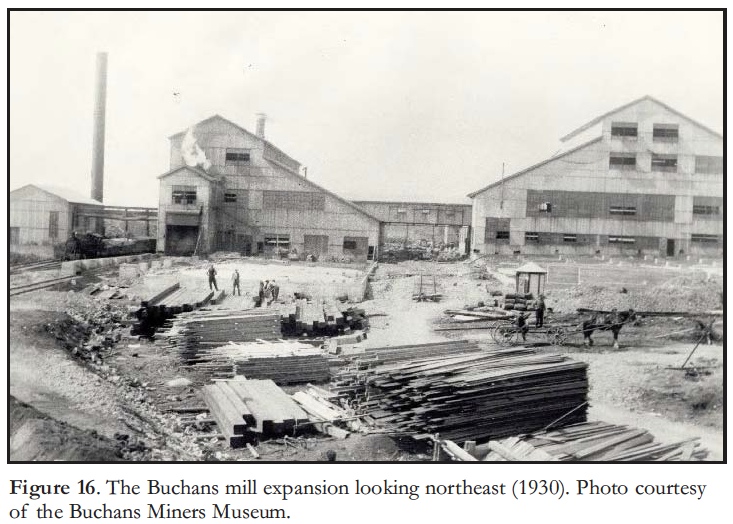
Display large image of Figure 16
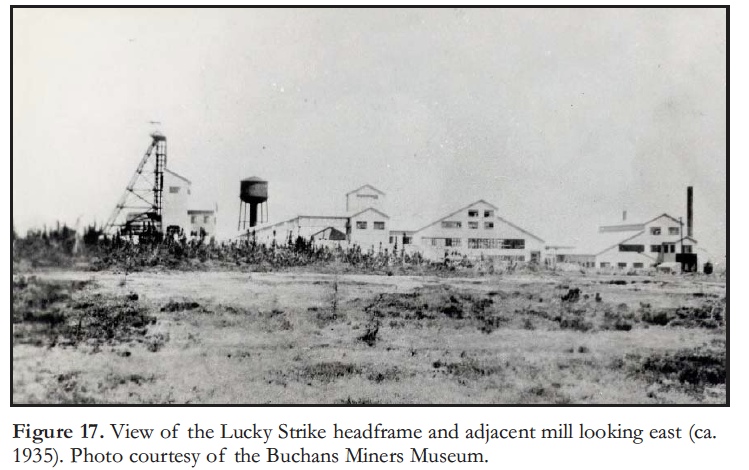
Display large image of Figure 17

Display large image of Figure 18
75 The workforce at Buchans fared much better than most Newfoundland communities during this difficult period, as full employment was maintained throughout. However, there were salary cuts of 10% for senior staff in February 1932 and a cut of 10% in salaries and wages for all employees earning more than $3 per day in 1932.
76 Throughout the remainder of the 1930s, production was maintained at full capacity. At the Lucky Strike mine, open-pit (glory-hole) mining (Fig. 18) was conducted during the summer, in places where glacial cover was less than 30 m in thickness, and underground mining from sub-level stopes was conducted during the winter. Where the overburden was too deep for surface mining, the ore was mined with vertical cut and fill stopes. After the limits of the Oriental deposit were determined with a drilling program in 1930, a 2100 m tunnel was driven eastward from the Lucky Strike shaft to the Oriental mine (Fig. 9) between March 1932 and October 1934. This provided underground haulage between the Oriental mine and the Lucky Strike mill. A new 126 m shaft for handling men and supplies at Oriental was started in May of 1932 and completed in October of the following year. Production from Oriental commenced in January of 1935.
77 The success of the Buchans operation in the early days depended upon metallurgical improvements, including the duplication, under conditions of full-scale production, of the test results that ASARCO had achieved in the lab. Two factors inhibited optimum metallurgical recoveries. One was the refractory character of some of the near-surface ore caused by oxidation of sulphide minerals by ground-water moving through fractures. Second, much of the ore was so fine-grained that galena and sphalerite could not be completely separated by grinding to the practical limit of approximately 100 microns. The character of the sulphide intergrowths varied considerably in different parts of the orebody, even within individual stopes, and variations of several percent in zinc, lead and iron content of the mill feed were common. Fine-grained parts of the deposit having a high pyrite and chalcopyrite content were also particularly refractory. Some of the more highly oxidized ore at the bedrock surface was stripped and stockpiled for future treatment. Although the complex Buchans ore continued to test the skill of the milling experts, expectations were exceeded after a few years of aggressive study and experimentation.
78 Many improvements in the science and art of milling complex base-metal sulphides were pioneered at Buchans, and the Buchans concentrator was noted for its complicated and sometimes innovative processes. In 1935, however, intensive laboratory research led to a major metallurgical development that used sulphur dioxide gas to produce a separate copper concentrate. Progress was also made in the recovery of gold and silver in the ore. In December 1931, gravity concentration was introduced to produce a gold–iron concentrate. It was improved by the addition of tabling in 1933 and the use of corduroy launders in 1934. By 1936, regular production from the Buchans operation consisted of separate concentrates of copper, lead and zinc, plus a gravity concentrate. The average metal content of the first three products was approximately 24% copper, 59% lead and 54% zinc. The gravity concentrate, which was discontinued in 1976, averaged 9.5 ounces of gold and 49 ounces of silver per ton. Readers who are interested in detailed information concerning milling practices at Buchans are referred to technical papers by Hellstrand and George (1934) and Maher and Powell (1965).
79 As world economies began a slow recovery after the depression, metal prices gradually improved. The net smelter value of Buchans ore rose from a low of $3.01 per tonne in 1932 to $9.07 in 1939, but the rise in the cost of production was much less, from $2.40 per tonne after the mill expansion in 1931, to $4.30 per tonne by 1939. The result was that earnings from the mining operation had fully repaid the capital investment, including interest charges, by the end of 1940. Additional accumulated earnings, after capital recovery, amounted to approximately $5.5 million, which was shared equally between BMC (ASARCO’s subsidiary) and TNP.
80 In September 1939, Newfoundland automatically joined Great Britain in World War II and the effects of the war were felt in many ways at Buchans. After metal production was declared a strategic priority, marketing was managed by special government agencies and shipments of lead and zinc to the traditional markets in Belgium and Germany were terminated. Although de mand for copper, lead and zinc was brisk, the sale of these commodities was subject to price controls and other official restraints. Zinc concentrates were sold to the British Metal Controller in London and copper and lead to the Metals Reserve Company in Washington. Buchans was also handicapped by soaring shipping rates and the uncertain hazards of maritime shipments. During the first three years of the war, zinc concentrates, based on 51.5% zinc, were sold for $11.81 per tonne aboard ship at Botwood, which was equivalent to approximately $0.01/lb ($0.022/kg) for the metal. Copper and lead were also sold at reduced prices. The net smelter value of Buchans ore dropped from an average of $9.07 per tonne in 1939 to $5.74 in 1940.
81 Despite the low prices received for its products, the mining industry in North America responded magnificently to the demand for metals and minerals for national defence. Production was pushed to the limit of available resources at Buchans. A record of nearly 440 000 tonnes of ore was mined and milled in 1940, an average of approximately 1200 tonnes per day compared to a rated capacity of 1100 tonnes. This excellent performance was achieved despite shortages of supplies and services. Shortage of manpower was probably the biggest headache because many enlisted in the armed forces, whereas others were attracted to the boom in defence construc tion in Newfoundland and Labrador. Labour turnover peaked in 1945, when a total of 1038 men were hired throughout the year to maintain an average work force of 723.
82 The end of the war in 1945 brought the return of free markets and a dramatic improvement in financial returns and operating conditions for the Company. There was no slackening of demand for most metals, and prices were unprecedented for peacetime. There was also a substantial alleviation of labour shortages. Unfortunately, the good economic times were dimmed by the prospect that the mine would soon run out of ore. The tremendous increase in production as part of the war effort had hastened the depletion of known ore reserves, which had declined to 1.8 million tonnes by the end of 1945, equivalent to five years of mine life.
Community Development
83 In the early 1900s, mining towns in isolated areas were created solely to serve the company by providing a stable workforce for the life of the mine. The company built the community and maintained it as long as the economics of the operation permitted. At Buchans, BMC provided housing, municipal services, a hospital, schools, and recreation facilities. The government provided the postal, customs and law enforcement services. Religious organizations built their own churches on land leased from the company. The various shops were operated as independent private business enterprises, also on land leased from the company. Buchans evolved as a true company town and, moreover, since the company held surface rights to the countryside for many miles around, it rigidly prevented any unregulated expansion nearby. The only means of access was via the company-owned railroad, so Buchans was, in effect, a closed company town. Although this arrangement would not be acceptable today, it was a very successful arrangement in the initial two decades for which the town was planned.
84 The construction of the town began early in the spring of 1927. The original sketches for the town layout were made by Williams and Gilchrist at Buchans, and scrutinized, modified and approved by Guess and Goodwin in New York. The much-used trail between the Buchans River prospect and the Lucky Strike mine was established as Main Street (Figs. 19, 20). A pattern of streets running perpendicular and parallel to Main Street was laid out to form rectangular blocks for housing. A feature peculiar in Newfoundland was the provision of nar row service streets at the rear of the rows of cottages, which became known in Buchans as garbage streets. The movement of equipment, particularly during the rush of the construction period, created thoroughfares ankle-deep in mud. To combat this problem the streets were corduroyed and surfaced with waste rock from the mine. A wooden sidewalk was built along the main street, reminiscent of the ‘Old West’.
Figure 19. Main Street Buchans looking west-southwest (ca. 1926). Photo courtesy of the Buchans Miners Museum.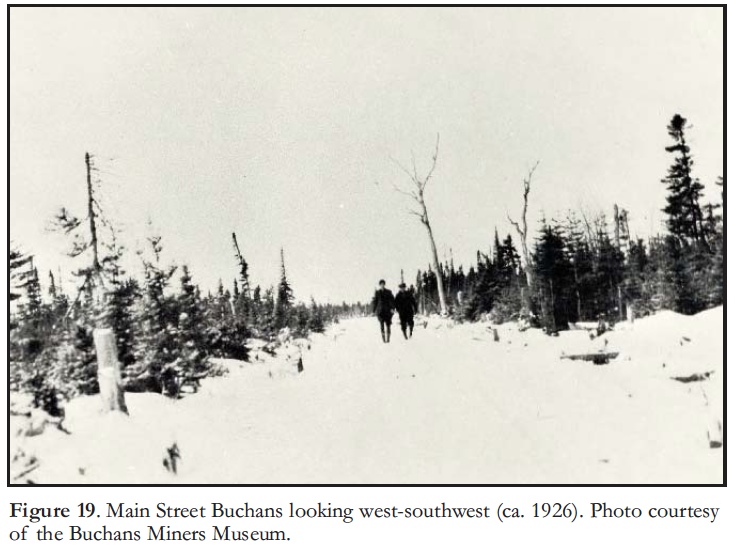
Display large image of Figure 19
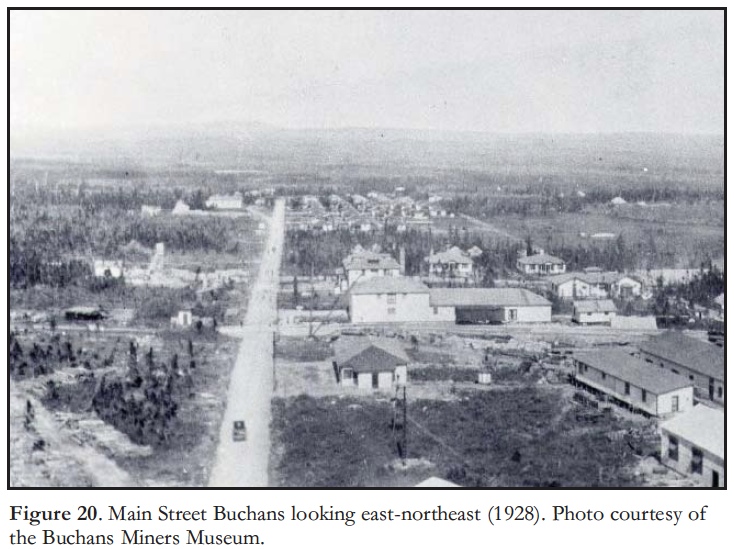
Display large image of Figure 20
85 When production of concentrates commenced in September, 1928, there were 56 housing units in the town, as well as an apartment house, a staff house and several bunkhouses. The school opened in the first week of September 1928 and the hospital opened in January. A town hall and social centre was completed in 1929 along with recreation facilities, including three tennis courts, an athletic field for soccer and baseball, and a ski run on a nearby hill. One of the concentrate storage sheds was equipped and flooded during the winter months as a skating and hockey rink. The three principal religious denominations on the island, The Roman Catholic Church, The Church of England and The United Church, had completed per manent church buildings by the end of 1929. The Salvation Army established a Citadel shortly afterwards.
86 The 1933 Newfoundland Royal Commission Report, generally referred to as the Amulree Report, described the town in the following manner:"The Town of Buchans is remarkable as being one of the few settlements in the interior of Newfoundland. So far removed from the sea and from other towns, the people are thrown to a large extent upon their own resources. The Company has provided them with facilities for education, recreation and amusement, and we were struck by the progressive spirit which prevailed. The town has been attrac tively laid out and is equipped with an excellent water supply, modern drainage and electric light. The Company maintains a school, and there is also a night school for workers in the mine. A cinema theatre serves also as a town hall. There is a flourishing athletic club. A hospital, with a resident medical officer and two nurses, is maintained by the Company. The population of Buchans is about 1000, of whom about 300 are employed in the mine. Wages are good and relations between the employees and the manage ment are excellent. Prices in the stores are high, owing to the distance of the town from the coast and to discriminatory railway freight rates. As at Grand Falls, the high birth-rate at Buchans gives rise to some anxiety. Indeed, the future of the town itself may be said to hang in the balance, since, if no further bodies of ore can be discovered, the mine will be exhausted in 1947. The problem of providing for the coming generation of Newfoundlanders is one to which we have referred elsewhere; the solution of the special problem of Buchans will, it is hoped, be found in the discovery of other workable deposits."
87 Municipal services at Buchans in its first decade were probably the best of any community on the island. All houses were equipped with water and sewage systems and garbage was collected daily. Electricity was supplied at every home. Company regulations aimed at maintaining good hygiene and sanitation standards were rigidly enforced. The company trained and equipped a volunteer fire brigade and installed a network of fire hydrants throughout the town. Facilities for health care and education were also excellent. The community had an upto-date hospital with a full time staff of one doctor and two nurses. The company maintained an all-grade public school with competent teachers, which was steam heated, sanitary, and comfortable in every respect. In 1930, the Catholic Church opened its own school and for a number of years sponsored a night school for adults. Buchans had quickly developed into an orderly and independent community with a full range of services and facilities. It bore little resemblance to the prevailing notion of a mining town.
88 Buchans was a tightly managed and closely regulated company town but there were negative side effects of this arrangement, of which the development of a form of social stratification was probably the most notable and damaging to the community. The population was divided into three groups. Single-status men occupied the bunkhouses that were located at one end of the town; married employees and their families lived in the main central part of the community, whereas senior company staff and management resided with their families in a small area near the mill at the other end of the town. To attract and retain professional personnel from the United States and Canada, the company provided a better level of housing and services than those provided to other householders. Moreover, since these professionals dwelt together in one neighbourhood and did not always share the same background and interests as the other residents, the staff people, not surprisingly, developed their own social clique. The single-status bunkhouse employees, who comprised about half of the total workforce, formed a unique group in the community. A number of them had families but could not obtain accommodation in the town; others preferred to maintain their families in their outport homes, whereas many were unmarried. These employees were transient and lived a care-free lifestyle that was often at variance with the family-oriented values of the others. Integration with the community was naturally difficult. These divisions within the community did not have any serious effect on the quality of life in the early days, but they became a source of rankling aggrava tion as the town became more settled.
New Discoveries (1946 – 1950)
89 The early exploration success achieved by Lundberg and Williams in 1926 had created a mood of optimism that additional orebodies would soon be found, which attracted other mining companies. An initial flurry of feverish prospecting activity resulted in claim-staking on ground bordering AND lands but did not result in any new discoveries. Additional geophysical surveys conducted by Hans Lundberg from 1926 to 1933, and again from 1937 until 1941 also failed to find any additional deposits. Likewise, conventional exploration methods and diamond-drilling programs had also been unsuccessful. The search had also been broadened through geological reconnaissance to the outlying areas. In 1933, an aircraft was employed for the first time at Buchans to study the surrounding area in an attempt to define exploration targets. The phenomenal good fortune of 1926, however, did not repeat itself and the result obtained from the intensive search for new orebodies was negative.
90 As mining proceeded, some additional ore was encoun tered adjacent to the known orebodies but by the end of 1947, reserves had declined by 75%. Exploration drilling underground in the Lucky Strike Mine helped a little to slow down the rate of depletion. Ore reserves at the end of 1931 were approximately 5.5 million tonnes but had dropped to less than 1.4 million tonnes by the end of 1947. However, the mine produced approximately 6.2 million tonnes during this same interval indicating that an additional 2.1 million tonnes had been found after 1931.
91 After a careful review in 1945, ASARCO decided that it had to embark on an intense exploration program to bolster dwindling ore reserves. The search was concentrated in the immediate vicinity of the produc ing mines rather than exploring the outlying areas, and specific exploration targets were singled out for systematic examination within the compressed area. The renewed efforts proved to be timely and well conceived because new orebodies were discovered almost immediately adjacent to Lucky Strike.
Rothermere
92 The first of the new orebodies was discovered near the end of 1947 when sulphides were intersected immediately west of Lucky Strike (Fig. 8) by surface and underground diamond drill holes. A second one was found by systematic drilling in 1948. Since the discoveries were deeper than the Lucky Strike ore-bodies a new shaft was required for their recovery.
93 The new shaft (Fig. 21) was named in honour of the second Lord Rothermere, whose family had founded AND. It was collared in June 1949 and completed in August 1951 to a depth of 764 m. The Rothermere ore-bodies were found to contain approximately 3 million tonnes of high grade ore, equivalent to about 10 years of mine life.
Figure 21. The Rothermere Mine headframe looking south (1978). Photo courtesy of the Buchans Miners Museum.MacLean
94 During the sinking of the Rothermere shaft, the program of systematic surface drilling continued to the northwest and along the trend of the Rothermere discoveries; as a result, 18 m of high grade massive sulphides were encountered at a depth of approximately 650 m in February 1950. The Rothermere shaft was deepened to establish an exploration drift at the 700 m level for the purpose of exploring the massive sulphide intersection 790 m to the northwest. Drilling from this 700 m level revealed a new deposit of high grade ore. As most of this new orebody was deeper than the Rother-mere shaft and over 900 m distant, it was decided to sink a second shaft (MacLean), which was completed to a depth of 1075 m in March 1960 (Fig. 22). It was named in honour of Dr. H.J. MacLean, who was chief geologist at Buchans when the Rothermere and MacLean orebodies were discovered. The new orebody added another 3 million tonnes of high grade ore to known reserves, again equivalent to about 10 years of mine life.
Figure 22. The MacLean Mine headframe looking north (1978). Photo courtesy of the Buchans Miners Museum.Oriental No. 2
95 The last of the major new discoveries was made near the Oriental mine, approximately 1.5 km east of Lucky Strike. In 1953, geological remapping of an underground exploration drift in the Oriental mine, in conjunction with surface diamond drilling, revealed an occurr ence of fragmental sulphides within a breccia bed similar to one of the Rothermere orebodies. A subsequent electrical survey, using a drill hole equipotential method, tested all the accessible diamond-drill holes in the immediate area to estab lish a drilling target. The first hole drilled from surface, on the basis of the survey, intersected 10 m of ore-grade sulphides. Subsequent drilling outlined a new orebody, Oriental No. 2 (Fig. 23), which contained approximately 0.8 million tonnes of ore and was mined as an extension of the existing Oriental mine. The discovery added in excess of two years to the mine life of Buchans.
Figure 23. The Oriental Mine headframe (1959). Photo courtesy of the Buchans Miners Museum.The Transformation Period (1950 – 1984)
96 The ore discoveries made between 1947 and 1953 marked the beginning of a new phase in the development of the company and the community of Buchans. In addition to developing the new orebodies for production, BMC also carried out a program of large-scale improvements to its plant. Major projects included a concrete dam across the Buchans River at Sandy Lake, a new central heating plant, and a sand system for backfilling the mine.
97 The town, which had been on the verge of becoming a ghost town, was revitalized by the new ore reserves. The company built new housing units and businesses expanded. In 1957, BMC opened a modern, well-equipped, 20-bed hospi tal; the following year, a branch of the Boys’ Club was organized. The Buchans Lions Club was formed in 1960. A new Salvation Army Citadel and Roman Catholic convent were also built during this period. In addition, the company provided a recreation centre and assisted with the construction of an outdoor swimming pool, and a sailing club was organized on nearby Sandy Lake. A highlight of the era was the establishment of a powerful senior hockey team, the Buchans Miners.
98 Two events occurred within this period that gradually changed Buchans from a transient isolated mining town to a settled community. The first event was the completion of a road link to the provincial highway system. Although location surveys commenced in 1948, the road did not become passable until 1956. The second was the establishment of a subdivision adjacent to the company-administered town (Figs. 24, 25). A new townsite was laid out by the province in 1963 on land provided by the companies (AND and BMC). It was incorpo rated as the Local Improvement District of Buchans and became a municipality with an elected council in 1973. The new housing area became known as the ‘Townsite’ and provided residents with the opportunity to own their own homes and to manage municipal affairs independently of the company. The isolation and closed town atmosphere slowly disappeared.
Figure 24. View of Buchans looking northwest toward ASARCO storage sheds and Gilchrist Street (left of storage sheds). Photo courtesy of the Buchans Miners Museum.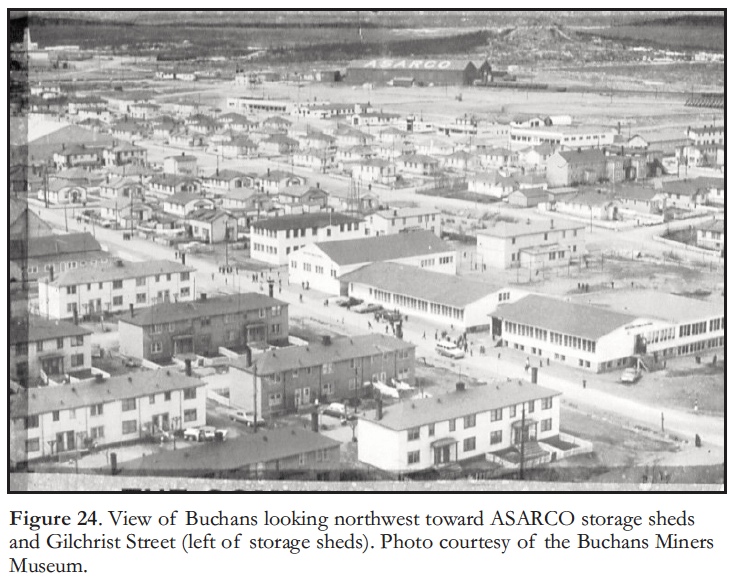
Display large image of Figure 24
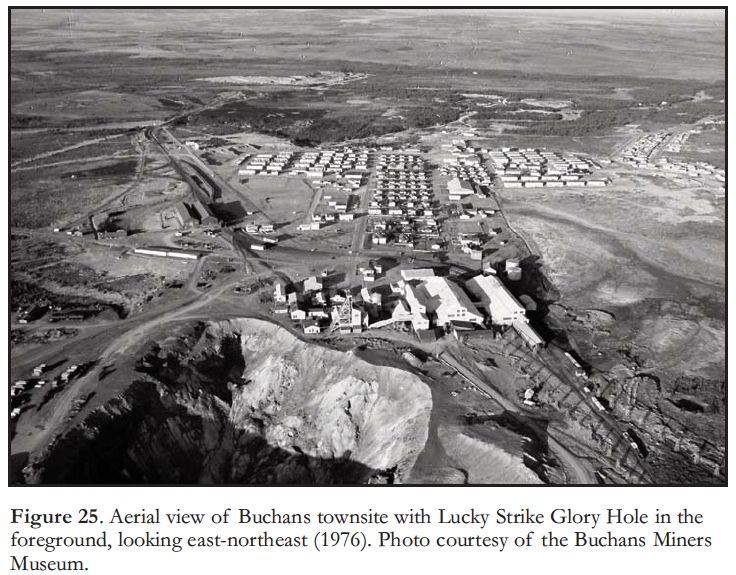
Display large image of Figure 25
99 In the wake of these events, Buchans enjoyed a decade or more of prosperity and relative security. The town had largely overcome its growing pains and became a stable community with residents who were optimistic for the future. The long awaited completion of the Newfoundland part of the Trans-Canada Highway and the paving of the Buchans access highway, plus the establishment of the townsite, brought a new sense of freedom and independence. The mine was producing at full capacity and the financial return was excellent. Houses and surrounding property were well maintained by the standards of the day and BMC was generous in its support of social and recreational activities. During the decade 1960 to 1970, a new modern arena, with artificial ice, was built, streets were paved and a system of storm sewers installed. A new fire-hall and library were provided by the company and a curling rink with club facilities was built with company support. Church properties and schools were expanded and improved. The Lions Club added a children’s play -ground to the existing recreational facilities. The Buchans Miners hockey team, a focal point of community spirit through the long winters, received the moral and financial support of the company. The social life of Buchans became more diver sified and the opening of several bar/lounge facilities was a feature of the times.
100 The Buchans mill continued to operate at rated capacity for many years follow ing the development of the new orebodies. Production from the Lucky Strike mine gradually petered out and terminated with the mining of some glory hole remnants in 1958. Over a life span of 30 years, it produced over 6.3 million tonnes of ore. The Oriental mine continued to produce until 1969. It contributed a total of 3.3 million tonnes during its 35 years of operation. At Old Buchans, the site of the original 1905 discovery, where mining finally began in 1943, the old shaft was used to re-examine the Main orebody but mining was carried out via an underground connection with the nearby Oriental mine. The Conglomerate orebody was mined by open pit. Altogether, nearly 197 000 tonnes of ore came from Old Buchans when mining ceased in 1955.
101 The deeper Rothermere and MacLean orebodies, which produced the bulk of the mill feed over the last thirty years of operation, were more difficult and costly to develop and mine than the relatively shallow Lucky Strike and Oriental orebodies. The mining method was cut-and-fill stoping, followed by pillar removal using the square set method. The voids left after the extraction of the ore were filled with sand from a surface pit that was operated during the summer months. Because of the high grade of the ore, mine planning aimed at 100% extraction. Production costs rose rapidly as mining went deeper. However, metal prices had improved dramatically after World War II and continued strong, so the growth in net smelt er value of the ore outpaced the increasing production cost. Except for some short periods of weak metal prices, the operation enjoyed a period of consistently good profits until the end of the 1960s.
102 By 1970, ore reserves became so de pleted that full production could no longer be maintained. An aggressive exploration program was maintained but it failed to identify any new ore-bodies. This program was not limited to the Buchans area but covered outlying areas totalling some 20 000 km2. Several finds of significant mineralization were made in these outlying areas but they were uneconomic to develop because of low tonnages, low grades or inaccessibility. The 1970s saw a gradual decline in mine output in line with diminishing reserves.
103 The decade from 1970 to 1980 was the most turbulent one in Buchans’ fifty year history. The underlying cause was the developing atmosphere of uncertainty that faced the company and the community. By 1971, the life expectancy of the mine was down to seven years and concentrate production was declining while costs were rising rapidly, aggravated by unstable metal prices and spiralling inflation. Although the Buchans operation had an enviable record of labour peace during its first 45 years, these difficulties found expression in growing management–labour confrontation that culminated in two long and bitter strikes in 1971 and 1973.
104 The first strike lasted from June 12 to November 12, 1971 and the second from March 15 to October 2, 1973. The second was the longest and most bitter, only ending after the province agreed to commission an industrial inquiry of BMC’s operation. The disputes were marked by an unprecedented show of union militancy and solidarity. Anti-company sentiment created a tense and fractious atmosphere in the close-knit community, which further emphasized social divisions and was marked by the destruction of com pany property.
105 The 1971 and 1973 strikes were an expression not only of the mine’s economic plight as perceived by the workers, but also the social concerns of the townspeople as a whole. Buchans was still a company town and the concept that the town existed to serve the industry was the guiding principle of company policy. There was no provision in the company’s administration of the community to provide for continuity beyond the closing of the mines. In years past, this was considered the normal and reasonable final chapter of a mining town, and it became the fate of numerous such com munities. However, social attitudes were changing fast, and the resistance of the company to change had contributed to the growing discontent that found an outlet in the two strikes.
106 The original 1928 Agreement between AND (which became Price Newfoundland Pulp & Paper Limited, a subsidiary of Abitibi-Price Inc.) and ASARCO was scheduled to expire on March 17, 1976. It was extended by a new Co-tenancy Agreement that came into force on January 1, 1976. The terms of this agreement reflected the determination of Abitibi-Price Inc. to play a larger role in the development of mineral rights on its land holdings. Under the new agreement, the cotenancy operation was to be managed by an owners’ committee having equal represen tation from the two companies. Abitibi-Price was responsible for exploration programs and ASARCO was responsible for production. The Mineral Resources Division of Abitibi-Price assumed management of all exploration previously supervised by the ASARCO geological staff at Buchans. Abitibi-Price was optimistic that some previously identified mineral de posits within modern trucking distance from the mill could be identified and, therefore, it maintained a vigorous exploration program between 1976 and 1985. It was this fresh and enthusiastic approach that buoyed the hopes for continued mining operations in the community.
107 As the last remnants of the MacLean orebody were extracted, daily mine production was reduced to approximately 300 tonnes per day in June 1980, compared with 1100 tonnes per day in 1978. However, an increase in metal prices and a new exploration program at the bottom of the MacLean mine gave a brief reprieve. The discovery of additional ore, called MacLean Extension, extended the life of the mine to August 1984, when it finally closed after 56 years of production. George Neary was the General Manager at the mine during the closing years and stayed on after the mine closed to manage the ongoing decommissioning of the site and increasingly important environmental programs.
108 The final diluted mill heads amounted to slightly over 16 million tonnes of ore with an average grade of 14.51% Zn, 7.56% Pb, 1.33% Cu, 126 g/t (3.7 oz/ton) Ag and 1.37 g/t (0.04 oz/ton) Au, making Buchans one of Canada’s richest volcanogenic massive sulphide deposits.
The Dénouement
109 In 1985, Abitibi-Price ended the 80-year venture of a forestry company in the mineral business by selling the large area of mineral rights surrounding Buchans to BP Canada Inc. After a period of renewed exploration, which resulted in the discovery of a number of new prospects, BP also announced its plan to exit the mining business and sold the mineral rights to Noranda Inc. in 1991. Noranda continued exploration but subsequently parcelled parts of the ground to junior exploration companies and allowed other areas to return to the Crown. In August of 1995 the mineral rights to most of the immediate Buchans area were opened for staking for the first time and the subsequent staking rush ushered in a new era of competitive mineral exploration by junior exploration companies that continues to this day. Though new discoveries have been elusive, there is currently an initiative to evaluate larger volumes of near-surface ‘low grade’ stringer mineralization (originally discovered by Lundberg) upon which much of the former mine infrastructure once stood.
110 A plant designed to separate barite from mine tailings was built in the late 1970s and it has since continued to operate intermittently under a number of banners, providing employment to a dozen or more Buchaneers. However, most of the skilled miners gradually drifted out of the province after closure of the mine to become integral parts of the Canadian mining scene at places like Hemlo and Manitouwadge in Ontario. However, the mining heritage lives on, as a younger generation works at Teck-Cominco’s Duck Pond Operation, a modern massive sulphide mine, discovered southeast of Red Indian Lake by a Noranda–BP joint venture. With less than 900 residents, the population of Buchans is currently less than a third of what it was in the glory days of the 1950s and 1960s. The proposals to improve road links from Buchans to the Trans-Canada Highway are still the subject of political debate with little concrete progress evident. For now, the town of Buchans is still ‘at the end of the road’.
GEOLOGICAL SETTING
111 This summary is based upon the accumulated knowledge of mine geologists at Buchans combined with significant collaborative company–university–government-sponsored research projects. Chief among these are GAC Special Paper 22 (Swanson et al. 1981), which commemorated 50 years of geology and mining, GSC Paper 86-24 (Kirkham 1987), which contains a collection of papers describing the results of the 1982-84 Canada–Newfoundland Mineral Development Program at Buchans, and the currently ongoing Targeted Geoscience Initiative 3 project operated by the Geological Survey of Canada.
Regional Geology
112 The island of Newfoundland presents a geological cross-section through the northern part of the Appalachian Orogen and has been divided into four tectonic zones (Fig. 26): from west to east, the Humber, Dunnage, Gander and Avalon zones (Williams 1964). Collectively, these zones record the opening and closing of the Iapetus Ocean in the late Precambrian and early Paleozoic (Williams 1979).
113 The Humber Zone represents the continental margin of Laurentia and consists of Precambrian crystalline rocks overlain by Paleozoic shelf-facies rocks. The Avalon Zone represents part of Gondwana and largely consists of late Precambrian plutonic, volcanic and sedimentary rocks having North African affinities. The Gander Zone represents mainly sedimentary rocks believed to have been deposited near the eastern continental margin of the Iapetus Ocean. The Dunnage Zone represents the vestiges of the Iapetus Ocean. Rocks within this zone consist of volcanic and sedimentary rocks of oceanic, back-arc and island-arc affinity created during the opening and subsequent closure of Iapetus.
114 Buchans is located in west-central Newfoundland within the Notre Dame Subzone of the Dunnage Zone (Williams et al. 1988), which is bounded by the Baie Verte–Brompton Line to the west and the Red Indian Line to the east (Fig. 26). More recently, the southern part of this Subzone has been referred to as the Dashwoods Subzone (Lissenberg et al. 2005) because it has a Precambrian basement (the ‘Dashwoods Block’ of Waldron and van Staal 2001) that the northern part lacks. The Red Indian Line is a complex deformation zone that is several kilometres wide/thick and separates Ordovician and older rocks formed near Laurentia from coeval rocks formed near Gondwana (van Staal et al. 1998, 2007). Therefore, it represents the suture zone of the former Iapetus Ocean in central Newfoundland.
Figure 26. Lithotectonic zones of Newfoundland showing the simplified regional geology and the location of Buchans (after Zagorevski et al. 2006). RIL: Red Indian Line; BVBL: Baie Verte – Brompton Line; HMT: Hungry Mountain Thrust.
Display large image of Figure 26
115 The Notre Dame/Dashwoods Subzone is entirely allochthonous and comprises western and eastern parts. In the western part, the oldest rocks (507–484 Ma) are supra-subduction-zone ophiolites of the Baie Verte Oceanic Tract, which are overlain by calc-alkaline volcanic rocks that are intruded by 488–456 Ma arc plutons of the Notre Dame Arc (van Staal et al. 1998). In the eastern part, the Annieopsquotch Accretionary Tract (AAT) comprises a complex east-ver-gent thrust stack of ophiolites and arc-back-arc complexes that is bounded to the west by the Lloyds River–Hungry Mountain fault system and to the east by the Red Indian Line (Lissenberg et al. 2005; Zagorevski et al. 2006; Figs. 26, 27). The AAT encompasses the Annieopsquotch ophiolite belt (ca. 480 Ma), the Lloyds River ophiolite complex (ca. 473 Ma), and the Buchans (ca. 463 Ma) and Red Indian Lake (465–460 Ma) groups (Fig. 27); the latter two are predominantly bimodal ensialic calc-alkaline arc sequences (Zagorevski et al. 2006). The Buchans Group contains the host rocks to the orebodies and is described in more detail below.
Figure 27. Schematic section across the Annieopsquotch Accretionary Tract showing the main lithotectonic elements and their respective ages (modified after Zagorevski et al. 2006).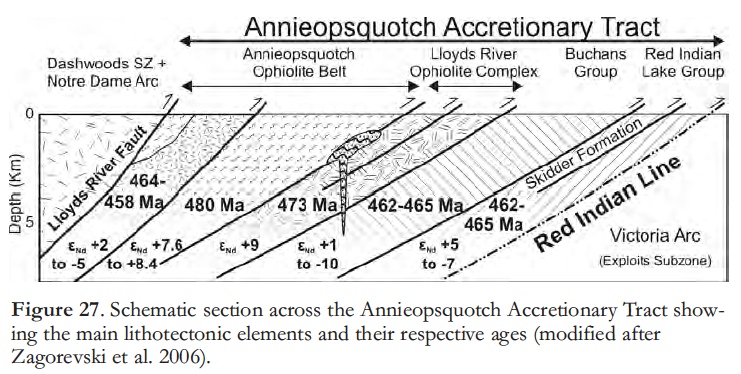
Display large image of Figure 27
116 The Notre Dame Arc and its Baie Verte ophiolitic basement were accreted to Laurentia during phase 2 of the Taconic Orogeny, which ended during the Middle Ordovician (van Staal et al. 2007). More specifically, the AAT was generated above a single west-dipping subduction zone out-board of the Laurentian margin. Accretion took place in two main stages: the first corresponding with collision of the peri-Laurentian Dash-woods micro-continent at ca. 468 Ma and the second corresponding with collision of the peri-Gondwanan Victoria Arc at ca. 450 Ma (Zagorevski et al. 2006; Fig. 27).
Buchans Area Geology
Glacial History
117 The glacial history of the Buchans area has been described by several authors, including James and Perkins (1981), Sparkes (1985), Klassen and Murton (1996), and most recently, Batterson and Taylor (2008). James and Perkins (1981) noted that the area is blanketed by extensive glacial deposits that range in thickness from < 1 to 55 m and average 7 m. (Notably, it was this extensive blanket that interfered with conventional prospecting and made Lundberg’s geophysical survey such an essential part of the Buchans discovery.) They reported three ice-flow directions, as follows: "…a dominant southwesterly directed ice movement, a prominent southeasterly movement, and an obscure east-northeasterly directed movement." They also pointed out that a glacial dispersion train, which extends more than 8 km southwest of Buchans, contains mineralized clasts or erratics.
118 Other authors focused on the glacial deposits at Buchans. Sparkes (1985) recognized two distinct till units: an older one containing volcanic rocks and a younger one containing granitic debris; in places, the two are separated by proglacial-lake deposits (rhythmites). He concluded that the earliest ice flow was southward and was succeeded by both southwestward and northeastward flow from an ice centre south of Red Indian Lake. Klassen and Murton (1996) identified up to five depositional units in seven stratigraphic sections; these were interpreted to represent at least two glacial events and an intervening ice-free period marked by a large glacial lake that occupied the Red Indian Lake basin. They identified four ice-flow events:
- Early southward flow;
- Regional northeastward flow, possibly followed by a local south-westward flow;
- Northward and southward flow; and
- Late southwestward and northeast-ward flow.
119 Batterson and Taylor (2008) concur that the earliest ice flow was southward from highlands north and west of Buchans, which corresponds to event i) of Klassen and Murton (1996), and is related to the older till of Sparkes (1985). Subsequent westward to southwestward flow originated from a northwest–southeast trending ice divide that ran through the centre of the Red Indian Lake basin; this ice flow correlates with the younger till of Sparkes (1985) and probably corresponds to event ii) of Klassen and Murton (1996).
Tectonostratigraphy
120 The Buchans area is underlain by the Middle Ordovician Buchans Group, an allochthonous sequence of bimodal, submarine, calc-alkaline volcanic rocks that hosts the Buchans orebodies. The Buchans Group has been divided into four units, the Lundberg Hill, Ski Hill, Buchans River and Sandy Lake formations (in ascending stratigraphic order), based on relationships in structural panels between the Powerline Fault and the Airport Thrust (Thurlow and Swanson 1987; Fig. 28). More recently, Zagorevski et al. (2010) have proposed that the definitions of the Ski Hill and Buchans River formations be expanded to include, respectively, some Lundberg Hill and Sandy Lake rocks, that the Lundberg Hill Formation be abandoned, and that the stratigraphic order of the Buchans River and Sandy Lake formations be reversed. Herein, the original nomenclature is retained. The Lundberg Hill Formation, at the apparent stratigraphic base of the Buchans Group, consists of felsic volcanic, volcaniclastic and related clastic sedimentary rocks. It is overlain conformably by the Ski Hill Formation, dominantly composed of mafic pillow lavas and hyaloclastic breccias; the Ski Hill is gradationally overlain by the ore-bearing, felsic volcanic rocks of the Buchans River Formation. The Sandy Lake Formation constitutes the upper part of the group and consists of pillow lavas with interbedded fine to coarse litharenite of felsic volcanic derivation (locally termed ‘arkose’). The age of the Buchans Group is based on White-rockian conodonts recovered from carbonate clasts (Nowlan and Thurlow 1984, 1987) and U-Pb zircon ages (462 ± 3 and 465 ± 3 Ma) from the upper part of the unit (Zagorevski et al. 2007a). The internal stratigraphy of the group is summarized schematically in Figure 29. The Wiley’s River granodiorite (Fig. 29) does not crop out within the area of Figure 28, but it is considered to be the source of the granitoid clasts that occur in sedimentary breccia-conglomerates that are penecontemporaneous with ore deposition (Thurlow 1981; Stewart 1987).
Figure 28. Simplified geological map of the Buchans area, modified from Figure 3 of Thurlow et al. (1992). Buchans Group stratigraphy: 1 = Lundberg Hill Formation; 2 = Ski Hill Formation; 3 = Buchans River Formation; 4 = Sandy Lake Formation; Db = Siluro-Devonian diabase. Outlines of orebodies within the Buchans River Formation are projected to surface. Cross section A-A’ is shown in Figure 30.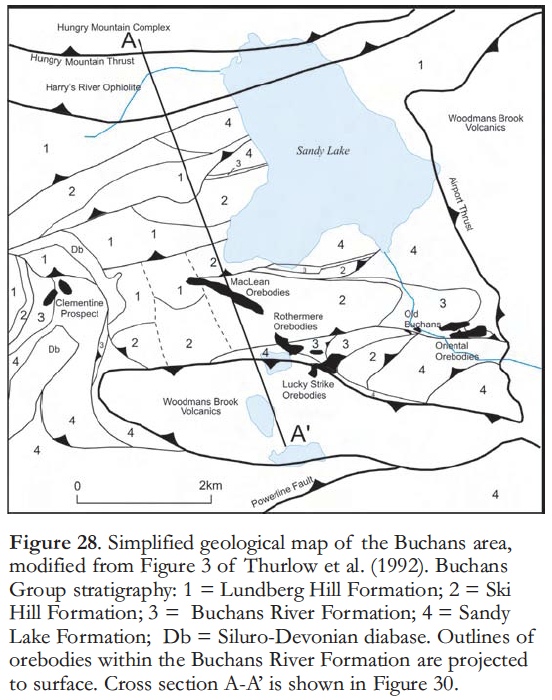
Display large image of Figure 28
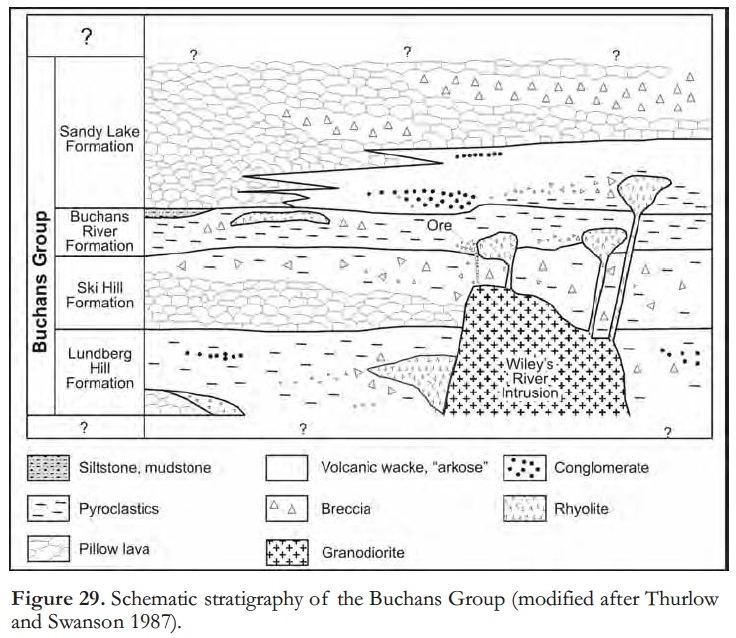
Display large image of Figure 29
121 The lower three formations of the Buchans Group are characterized by rapid lithologic variations and facies changes that indicate a proximal volcanic environment. Mafic volcanic rocks are dominantly basaltic and typically contain augite and plagioclase phenocrysts. Felsic rocks range from dacitic to rhyolitic in composition, and normally contain quartz and plagioclase phenocrysts; felsic rocks are commonly coarsely fragmental and are characterized by a considerable array of fragment types and sizes within and among units, as well as by variable amounts of juvenile volcanic material in the matrix. Discontinuous lenses of volcanic siltstone, wacke and conglomerate are commonly associated with the felsic pyroclastic units, but chemically precipitated sedimentary rocks (e.g. exhalites) are rare. The uppermost unit, the Sandy Lake Formation, is a regionally homogenous pillow-lava sequence that marks a significant change in depositional environment. The only occurrence of carbonate rocks is as fossiliferous clasts in breccias near the base of this formation. Graphitic sedimentary rocks are rare in the Buchans Group.
122 Southeast-directed, Ordovician (Taconic) thrust faulting affected all units of the Buchans Group (Thurlow and Swanson 1981, 1987; McClay 1987; Calon and Green 1987). Deformation was inhomogeneous, and relatively narrow, brittle-ductile fault/shear zones separate unstrained volcanic panels. The thrust system is dominated by duplex and antiformal stack geometries, which are nested at a variety of scales ranging from orebody-scale to that of the entire Buchans Group (Fig. 30). Zagorevski et al. (2007b) present evidence that similarly directed, Silurian (Salinic) thrust faults exploited the earlier thrusts, where convenient, but locally also caused imbrication of Ordovician and Silurian rocks.
123 The dominant structural feature in the area is historically referred to as the ‘Buchans anticline’ (the ‘antiformal stack’ of Calon and Green 1987; Fig. 30), which is manifested by a window of stratigraphic hangingwall rocks that lie structurally below the orebodies. Overprinting this structure is a small-scale, east–west-trending, doubly-plunging antiformal thrust stack that contains the Lucky Strike and Rothermere orebodies. Within this stack, the Lucky Strike orebodies have been interpreted (Calon and Green 1987) to occupy a smaller scale antiformal stack. The Oriental orebodies lie in a structurally higher panel and are themselves complexly thrust into a series of antiformal stacks (Calon and Green 1987).
Figure 30. Schematic NNW–SSE cross-section showing the geometry of the Buchans thrust stack, modified slightly from Calon and Greene (1987). LH = Lundberg Hill Formation; SH = Ski Hill Formation; BR = Buchans River Formation; SL = Sandy Lake Formation. Asterisks indicate positions of the main Buchans orebodies. See Figure 28 for location of cross section.
Display large image of Figure 30
124 The relatively incompetent mineralized and altered volcaniclastic rocks of the Ski Hill and Buchans River Formations served as a focus for strain. All the major orebodies are bounded on at least one side by thrust faults. There is strong evidence that these faults exploited earlier synvolcanic normal faults. These earlier structures, in turn, were important in controlling the sites of submarine hydrothermal discharge and the location of paleotopographic channels that host the transported (breccia–conglomerate) ores.
Ore Types
125 The Buchans orebodies belong to a class referred to as volcanogenic massive sulphide (VMS) deposits. Volcanogenic massive sulphide deposits are stratiform accumulations of sulphide minerals that precipitated from hydrothermal fluids onto the seafloor, or just beneath it, and are associated with volcanic rocks in a variety of geological settings. Prior to the 1960s, these deposits were thought to have formed deep in the crust by injection of granite-derived fluids into structural pathways. Geological reports from the 60s generally focused on structure as being the most important ore control.
126 Four distinct ore types were mined at Buchans: ‘in-situ ore’, ’transported ore’, ‘stockwork mineralization’, and ‘ore clasts in thrust faults’. The in-situ and transported ores were of approximately equal economic importance and accounted for 98% of production.
127 In-situ ore is the most poorly understood ore type because it was best developed at Lucky Strike and Oriental, both of which were largely mined out in the 1960s before any detailed studies were conducted. In-situ ore overlies the stockwork mineralization and is characterized by extensive internal imbrication on thrusts. Ore textures range from massive to brecciated, to a distinctive streaky or banded style. During the 1960s, the latter texture was regarded as (primary) sedimentary layering and the ores were therefore considered to be the ‘in-situ’ source deposits from which the transported ores were derived (Thurlow and Swanson 1981). The wispy, banded textures are now thought to be the product of ductile shear of pyrite-poor, high-grade massive sulphides. In less deformed specimens, the protolith of in-situ ore can locally be seen to be deformed transported ore, thereby suggesting the possibility that much or all of the known in-situ ore is actually deformed clastic ore.
128 Transported ore is perhaps better developed and preserved at Buchans than at any other VMS district in the world. The ore consists of unsorted, matrix-supported, re-sedimented, polylithic breccia–conglomerate that occurs within channel-fill sequences comprising felsic pyroclastics, barren polylithic breccias and fine-grained volcaniclastic rocks and wackes (Fig. 31). Ore grade is directly proportional to the abundance of ore clasts, including very high-grade black (sphalerite) ore, yellow (chalcopyrite) ore and barite, but bears no relation to the distance of transport from the presumed source areas.
Figure 31. A. Typical ‘transported ore’ on 20-level, MacLean Extension orebody. A number of black and yellow ore clasts are visible (a prominent black ore clast just above the author’s hand), as well as numerous barite clasts (white), grey siltstone (e.g. below the pencil), pinkish rhyolite and jet-black chloritic clasts. B. Cut slab of ‘transported ore’ showing two black ore clasts (centre), a rhyolite clast (upper right), a bleached basaltic clast (upper left), numerous grey siltstone clasts (some with altered rims), numerous small barite clasts (white), and jet-black chloritic clasts. Slab is approximately 25 cm wide.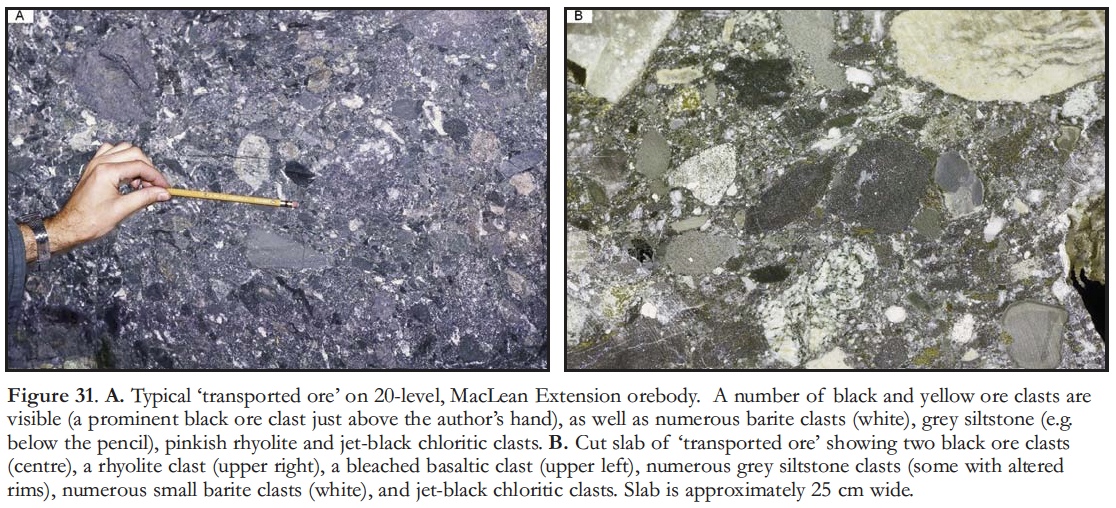
Display large image of Figure 31
129 A variety of clast types is found in the breccia–conglomerate units, especially rocks from the foot-wall of the deposits (e.g. pyritic silt-stone/wacke, rhyolite, felsic tuff, and an array of altered and mineralized basaltic rocks from the stockwork zone). Granitoid pebbles, cobbles and boulders are characteristic of some of the ore-bearing breccias. They are anomalous in terms of their composition, large size, and higher degree of rounding compared to other clast types.
130 Breccia–conglomerate ores are considered to have been transported downslope as a series of gravity-driven debris flows (Thurlow and Swanson 1981). Binney (1987) demonstrated that the many debris flows that constitute the MacLean Extension Orebody have elongate shapes with steep flow-fronts and marginal levees in which larger clasts are concentrated. Ore grade tends to increase toward the base of individual debris flows, suggesting some preferential settling of dense sulphide clasts. Shear stress during transport was greatest at the base of the debris flows and appears to have caused syn-sedimentary shearing of sulphide clasts (Kirkham and Thurlow 1987). Stratigraphically higher debris flows are generally more baritic, probably reflecting compositional changes at the source.
131 Stockwork mineralization is typical of the footwall of most VMS systems and consists of networks of veinlet and disseminated pyrite, and minor base-metal sulphides and barite. The stockwork mineralization and related alteration is superimposed upon the mafic volcanic rocks of the Ski Hill Formation and lowermost felsic volcanic rocks of the Buchans River Formation.
132 In the core of the stockwork, the host rocks are strongly silicified and/or chloritized, and contain numerous sulphide veins, but on the periphery, alteration is dominated by sericite and disseminated pyrite, and only minor base-metal sulphides are present. In the latter areas, ore-related vein-lets clearly cut an earlier barren silicification that exploited pathways generated by fracturing of the rocks along perlitic cracks. The low-grade stock-work ores are more pyritic than in-situ and transported ores and are, on a metal ratio basis, relatively more Cu-rich and Pb–Zn-poor.
133 Ore clasts in thrust faults is a type that is widespread but of minor importance economically. Several thrust fault zones contain mélange composed of high-grade massive sulphide clasts and abundant altered and mineralized rock fragments in a quartz-bearing, comminuted matrix. Ore clasts are contained within shallowly dipping thrust fault zones over a 2 km by 4 km area near and adjacent to Lucky Strike Orebody. The West Ore-body, a small satellite of Lucky Strike, is the best example of ore of this type.
Ore Controls
134 Transported breccia ore, the signature ore type that characterizes the Buchans deposits, occurs in elongate debris-flow deposits. These deposits are typically truncated along one side by a thrust fault and their thickness typically increases toward the fault. Exploration drilling for ‘the other half of the ore-body’ in the footwall of the thrust at MacLean and MacLean Extension ore-bodies returned little or no breccia ore, hence the ore-bounding thrusts have been interpreted as reactivated normal faults that once defined the margins of half grabens. The extensional tectonic regime prevailing during ore deposition (Fig. 32) is probably responsible, at least in part, for creating the channels that contained the transported ores (Thurlow and Swanson 1987; Binney 1987; McClay 1987). The area of intersection of the Lucky Strike/ MacLean and Oriental/Sandfill channel structures (now eroded) may have provided the deep structural pathway along which hydrothermal fluids were focused. The high-grade in-situ ores are presumed to have formed in typical VMS fashion as seafloor or subseafloor deposits at the site(s) of hydrothermal discharge above altered and mineralized footwall rocks. Brecciation of ore and footwall rocks probably occurred by slumping of ore and host rocks from the active margin of the evolving grabens (Fig. 32), a process aided by earthquakes and volcanic explosions. Granitoid cobbles were explosively transported to surface in pebble dykes (diatremes) at this time and may have breached the developing orebodies, causing further brecciation (Stewart 1987). The sulphide fragments and other clasts flowed down the channels as a series of elongate, gravity-driven debris flows. Though the debris flows travelled beyond the footwall alteration zones, their steep, boulder-rich flanks and snouts permit determination of transport direction from the Lucky Strike area (Binney 1987). The higher barite content of younger debris flows reflects the changing composition of mineralization in the source area over time. Transported ores were blanketed with felsic pyroclastic rocks, and the grabens were subsequently filled and levelled with a rapid influx of arkose and basalt of the Sandy Lake Formation.
Figure 32. A diagrammatic view of paleotopography during formation of the Buchans ores, showing graben structure, debris flows, and diatreme activity (after Kirkham and Thurlow 1987).
Display large image of Figure 32
135 With the onset of compressive stress, propagating thrusts exploited the phyllosilicate-rich alteration zones and reactivated many synvolcanic normal faults in a form of local ‘inversion tectonics’ (Thurlow and Swanson 1987). The empirical correlation between complex structural patterns and ore occurrence is therefore viewed as a fundamental ore control that is useful in local exploration.
THE IMPORTANCE OF THE BUCHANS MINE
136 One of the objectives of the Great Mining Camps of Canada series is to highlight the importance of each mining camp featured in the series, including the socio-economic significance and/or contribution to the development of new technologies or geoscientific concepts. Buchans is a particularly important deposit in many respects.
Socio-economic Impact
137 The development of a mining industry at Buchans came at a time when Newfoundland was desperately in need of employment and revenue. The financial position of the Crown Colony, which began to deteriorate after World War I, had gradually worsened. By 1933, the Colony was virtually bankrupt as it could no longer meet the interest payments on its foreign debts or find buyers for its bonds. Finally, in 1934, in return for the financial backing of Great Britain, Newfoundland’s Representative Government, which it had enjoyed for more than a century, was replaced by Government by Commission. Throughout the 1930s, the population (290 000) suffered greatly from the effects of worldwide depression.
138 Buchans was an outstanding contributor to the social and economic welfare of the Island during these bleak depression years. The town was a haven of steady and full employment and the industry fed much-needed cash into the Island’s economy. Wages were very good relative to other jobs available at the time, and the average number of people on the payroll was rarely less than 650. Annually, the mining opera tion at Buchans paid some $600 000 directly to government at a time when total government revenue averaged about $10 million. The total amount of money expended by the company in Newfoundland, including payments to government and to others by way of salaries, supplies and services, up to the year 1939, was $21 million. The operation was a particular blessing for the New foundland Railway, which had been forced to cut services and maintenance in an effort to continue operating. During the depression years, concentrate tonnage from Buchans represented roughly half of the total freight hauled and the freight revenue from the mining operation was a considerable item in the railway’s monthly income.
139 The labour strife of the early 1970s was an unfortunate series of events that were brought about by the burden of history, changing social norms and rapidly diminishing ore reserves at a time of great economic uncertainty. The events surrounding the strikes are burned into the memories of all who experienced them and these events have undoubtedly influenced the leaders of Canadian industry, labour and government organizations.
140 The presence of the Buchans Mine led to the development of infrastructure that would otherwise not exist in the central part of Newfoundland. For example, there would have been no reason to build the power line from Corner Brook to that part of the island. The paved highway from Badger on the Trans-Canada Highway to Red Indian Lake likely would not have been built, nor subsequently extended to Burgeo on the south coast (Fig. 1).
141 Despite a fledgling mining industry, the economy of early twentieth century Newfoundland was largely based upon the twin pillars of fishing and forestry. The mining development at Buchans marked the ascent of the mining industry, which, to this day, continues as a major contributor to the economy of the Province of Newfoundland and Labrador.
Geoscientific Significance
142 The Buchans VMS orebodies are geologically unusual in a number ways and absolutely unique in others. Their very rich grade, averaging 22% combined lead and zinc, was what made it possible for the mine to be developed in such a remote location and to remain in continuous production under what were often difficult circumstances. Buchans is unusually high grade, compared to most other VMS deposits worldwide, and the percentage of gangue minerals is relatively low. Iron sulphides (pyrite and/or pyrrhotite) are commonly the most abundant sulphide minerals in VMS ores; however, Buchans is unusual in that the average pyrite content is less than 10%.
143 The Buchans orebodies are jewels among Canada’s mineral deposits for their relatively pristine state of preservation. As such, they were important in the development of modern concepts of the genesis of VMS deposits. The concept of ‘transported orebodies’, wherein ore is carried downslope as gravity-driven debris flows from its source, was first recognized and described at Buchans. Indeed, more than half the ore mined at Buchans was of the ‘transported’ variety. Sulphide breccias are now widely recognized within and adjacent to VMS deposits; however, the scale of mechanically transported breccia ore and the distances of transport at Buchans remain unrivalled on a worldwide basis. During the 1960s and early 1970s, many sceptical touring geologists, after viewing sedimentary breccias studded with high-grade sulphide clasts, left Buchans converted to the new paradigm of seafloor deposition of VMS ores. In a more general sense, Buchans is unusual for the great variety, proportion and preservation of breccia rocks and is a laboratory for anyone wishing to become familiar with a spectrum of breccia textures and processes.
144 Another unique feature of the Buchans ores is the widespread occurrence of granitoid clasts within the breccia ores. The granitoid clasts are typically more rounded and larger in size than other rock and sulphide clasts with which they are associated. In some sedimentary breccias, termed ‘granite conglomerate’, they are the dominant clast type. Granitoid clasts are little more than a curiosity at a small number of VMS deposits worldwide, and nowhere do they approach the volumetric importance that they do at Buchans, where hundreds of thousands or even millions of tonnes of granitoid clasts form an integral part of the transported ores. Their origin, although controversial, speaks to unusual or even globally unique geological circumstances during ore formation at Buchans.
145 A perhaps unique aspect of Buchans geology is the widespread occurrence of high-grade sulphide clasts within thrust faults. These clasts are distributed continuously within sheets of cohesive cataclasite over a 2 x 4 km area in proximity to the Lucky Strike Orebody, and appear to be the remnants of an orebody that was dismembered and scattered by thrusting.
Technological Significance
146 Neary (1981) described, in some detail, how Hans Lundberg used electrical methods to discover both the Lucky Strike and Oriental orebodies in the summer of 1926. However, the geophysical significance of this pioneering work deserves additional emphasis. Although geophysical methods had met with some early success in both Europe and North America, electrical methods were still in their embryonic stage and it is clear that there were no prior geophysical discoveries on this continent that even remotely approach the significance of Lundberg’s finds at Buchans. The discovery of the Lucky Strike Orebody under an isolated central Newfoundland bog can rightly be called the first geophysical discovery of significant metallic ores in North America, and Lundberg has been described as the ‘Father of Canadian Geophysics’ (Cathro et al. 1993). Despite the name ascribed to the find, it is clear that technology, initiative and hard work were greater factors in its discovery than luck.
147 Decades later, in the 1940s, Lundberg experimented with measuring the metal contents of both lake-bottom sediments and vegetation as a means of detecting buried mineral deposits at Buchans. This work appears to be the first attempt to employ the new science of exploration geochemistry in Canada (Brummer et al. 1987).
148 Many improvements in the science and art of milling complex base metal sulphides were pioneered at Buchans by ASARCO, and the Buchans concentrator was noted for its complicated and sometimes innovative processes. In 1935, intensive laboratory research commenced at Buchans in an attempt to find and develop a profitable method for the recovery of copper. A satisfactory process that used sulphur dioxide gas was discovered and the production of a separate copper concentrate began in September 1936. This was a major metallurgical development that considerably enhanced the value of the Buchans ore, for which much credit is due to the ASARCO metallurgists and in particular to the milling staff working at Buchans.
ACKNOWLEDGEMENTS
I am grateful to Doreen Neary and to the Geological Association of Canada for permission to re-publish major parts of George Neary’s important historical research. Chris Pereira at the Government of Newfoundland and Labrador Department of Natural Resources arranged for digital scanning of the original text and Sean O’Brien arranged for Terry Sears to re-draft several of the figures. Liam O’Brien is the keeper of some of George Neary’s records and kindly supplied photographs, while Paul O’Brien of Buchans supplied photos and jogged my memory on factual information. Marie Jackman of the Grand Falls-Windsor Heritage Society, Marjorie Sheridan (daughter of George C. Gilchrist) and Alison Fitton (granddaughter of Harry A. Guess) also supplied photographs. Reg Wilson was instrumental in the final editing and formatting. This paper would not have been completed were it not for the ongoing encouragement of Steve McCutcheon and Bob Cathro. They were instrumental in supplying research and reducing the length of unwieldy early versions of the manuscript to a manageable size.REFERENCES
Batterson, M., and Taylor, D., 2008, Ice flow history and regional till-geochemistry sampling of the southern part of the Red Indian Lake basin, in Current Research 2008: Newfoundland and Labrador Department of Natural Resources, Geological Survey Report 08-1, p. 25-34.
Binney, W.P., 1987, A sedimentological investigation of MacLean channel transported sulphide ores, in R.V. Kirkham, ed., Buchans Geology, Newfoundland: Geological Survey of Canada, Paper 86-24, p. 107-147.
Brummer, J.J., Gleeson, C.F., and Hansuld, J.A., 1987, A historical perspective of exploration geochemistry in Canada – the first 20 years, in R.G. Garrett, ed., Geochemical Exploration 1985: Journal of Geochemical Exploration,.v. 28, p. 1-39.
Calon, T.J., and Green, F.K., 1987, Preliminary results of detailed structural analysis at Buchans, in Kirkham, R.V., ed., Buchans Geology, Newfoundland: Geological Survey of Canada, Paper 86-24, p. 273-288.
Cathro, R., 2006, Great mining camps of Canada: Announcing a new series: Geoscience Canada, v. 3, p. 56-59.
Cathro, R., Sheahan, P., and Thurlow, J.G., 1993, Hans Torkel Frederik Lundberg: Father of Canadian Geophysics. Canadian Institute of Mining and Metallurgy Bulletin, v. 86, No. 973, p. 22-25.
Dewitt, C.C., 1940, Froth flotation concentration: Industrial and Engineering Chemistry, v. 40, p. 652-658.
Galloway, J.D., 1926, Annual report of the Minister of Mines for the year ended 31st December 1925, p. 226-228: British Columbia Geological Survey website: [http://www.empr.gov.bc.ca/Mining/Geoscience/PublicationsCatalogue/AnnualReports/Pages/Annual-Reports.aspx].
Hellstrand, G.A., and George, P.W., 1934, Milling Practice at Buchans Mine, Buchans, Newfound land: American Institute of Mining Engineers, Technical Publication 573, 23 p.
James, L.D., and Perkins, E.W., 1981, Glacial dispersion from sulphide mineralization, Buchans area, Newfoundland, in E.A. Swanson, D.F. Strong, and Thurlow, J.G., eds,. The Buchans Ore-bodies: Fifty Years of Geology and Mining: Geological Association of Canada, Special Paper 22, p. 269-283.
Kirkham, R.V., ed., 1987, Buchans Geology, Newfoundland: Geological Survey of Canada, Paper 86-24, 288 p.
Kirkham, R.V., and Thurlow, J.G., 1987, Evaluation of a resurgent caldera and aspects of ore deposition and deformation at Buchans, in Kirkham, R.V., ed., Buchans Geology, Newfoundland: Geological Survey of Canada, Paper 86-24, p. 177-194.
Klassen, R.A., and Murton, J.B., 1996, Quaternary geology of the Buchans area, Newfoundland: Implications for mineral exploration: Canadian Journal of Earth Sciences, v. 33, p. 363-377.
Lissenberg, C.J., Zagorevski, A., McNicoll, V.J., van Staal, C.R., and Whalen, J.B., 2005, Assembly of the Annieopsquotch accretionary tract, Newfoundland Appalachians: Age and geodynamic constraints from syn-kinematic intrusions: Journal of Geology, v. 113, p. 553-570.
Lundberg, H., 1928, Recent Results in Electrical Prospecting for Ore: American Institute of Mining Engineers, Technical Publication 98, p. 118-122.
Maher, W.H., and Powell, C.R., 1965, Milling practice at Buchans, Newfoundland: Canadian Institute of Mining and Metallurgy Bulletin, v. 59, p. 869-871.
Marcosson, I.F., 1949, Metal Magic: The Story of the American Smelting and Refining Com pany: New York, Farrar Strauss, 313 p.
McClay, K.R., 1987, Aspects of the structural geology of the Buchans area, in Kirkham, R.V., ed., Buchans Geology, Newfoundland: Geological Survey of Canada, Paper 86-24, p. 47-57.
Neary, G.N., 1981, Mining History of the Buchans Area, in Swanson, E.A., Strong, D.F., and Thurlow, J.G., eds., The Buchans Orebodies: Fifty Years of Geology and Mining: Geological Association of Canada, Special Paper 22, p.1-64.
Nowlan, G.S., and Thurlow, J.G., 1984, Middle Ordovician conodonts from the Buchans Group, central Newfoundland, and their significance for regional stratigraphy of the Central Volcanic Belt: Canadian Journal of Earth Sciences, v. 21, p. 284-296.
Nowlan, G.S., and Thurlow, J.G., 1987, The significance of Middle Ordovician conodonts from the Buchans Group, in Kirkham, R.V., ed., Buchans Geology, Newfoundland: Geological Survey of Canada, Paper 86-24, p. 59-62.
Sparkes, B.G., 1985, Quaternary mapping, Central Volcanic Belt, in Current Research: Newfoundland Department of Mines and Energy, Geological Surveys Branch, Report 85-1, p. 94-98.
Stewart, P.W., 1987, Geology and genesis of granitoid clasts in the MacLean Extension transported orebody, in Kirkham, R.V., ed., Buchans Geology, Newfoundland: Geological Survey of Canada, Paper 86-24, p. 149-176.
Swanson, E.A., Strong, D.F., and Thurlow, J.G., eds., 1981, The Buchans Orebodies: Fifty Years of Geology and Mining: Geological Association of Canada, Special Paper 22, 350 p.
Thurlow, J.J., 1981, The Buchans Group: Its stratigraphic and structural setting, in Swanson, E.A., Strong, D.F. and Thurlow, J.G., eds., The Buchans Ore-bodies: Fifty Years of Geology and Mining: Geological Association of Canada, Special Paper 22, p.79-89.
Thurlow, J.G., and Swanson, E.A., 1981, Geology and ore deposits of the Buchans area, central Newfoundland, in Swanson, E.A., Strong, D.F. and Thurlow, J.G., eds., The Buchans Ore-bodies: Fifty Years of Geology and Mining: Geological Association of Canada, Special Paper 22, p.113-142.
Thurlow, J.G., and Swanson, E.A., 1987, Stratigraphy and structure of the Buchans Group, in Kirkham, R.V., ed., Buchans Geology, Newfoundland: Geological Survey of Canada, Paper 86-24, p. 35-46.
Thurlow, J.G., Spencer, C.P., Boerner, D.E., Reed, L.E., and Wright, J.A.,1992, Geological interpretation of a high resolution reflection seismic survey at the Buchans mine, Newfoundland: Canadian Journal; of Earth Sciences, v. 29, p. 2022-2037.
van Staal, C.R., Dewey, J.F., MacNiocaill, C., and McKerrow, W.S., 1998, The Cambrian-Silurian tectonic evolution of the northern Appalachians and British Caledonides: History of a complex, west and southwest Pacific-type segment of Iapetus, in Blundell, D.J., and Scott, A.C., eds., Lyell: The past is the key to the present: Geological Society [London] Special Publication 143, p. 199-242.
van Staal, C.R., Whalen, J.B., McNicoll, V.J., Pehrsson, S., Lissenberg, C.J., Zagorevski, A., van Breemen, O., and Jenner, G.A., 2007, The Notre Dame arc and the Taconic orogeny in Newfoundland, in Hatcher, R.D., Jr., Carlson, M.P., McBride, J.H., and Martínez Catalán, J.R., eds., 4-D Framework of Continental Crust: Geological Society of America, Memoir 200, p. 1-42.
Waldron, J.W.F., and van Staal, C.R., 2001, Taconian orogeny and the accretion of the Dashwoods block: A peri-Laurentian microcontinent in the Iapetus Ocean: Geology, v. 29, p. 811–814.
Williams, H., 1964, The Appalachians in northeastern Newfoundland – a two-sided symmetrical system: American Journal of Science, v. 262, p. 1137-1158.
Williams, H., 1979, Appalachian Orogen in Canada: Canadian Journal of Earth Science, v. 16, p. 792-807.
Williams, H., Colman-Sadd, S.P., and Swinden, H.S., 1988, Tectonic-stratigraphic subdivisions of central Newfoundland, in Current Research, Part B: Geological Survey of Canada, Paper 88-1B, p. 91–98.
Zagorevski, A., Rogers, N., van Staal, C.R., McNicoll, V.J., Lissenberg, C.J., and Valverde-Vaquero, P., 2006, Lower to Middle Ordovician evolution of peri-Laurentian arc and back-arc complexes in the Iapetus: Constraints from the Annieopsquotch accretionary tract, central Newfoundland: Geological Society of America Bulletin, v. 118, pp 324–342.
Zagorevski, A., McNicoll, V., van Staal, C., and Rogers, N., 2007a (abstract), Tectonic history of the Buchans Group: Evidence for late taconic accretion of a peri-Laurentian arc terrane and its reimbrication during the Salinic Orogeny: Geological Society of America, Northeastern Section, 42nd Annual Meeting, Durham, New Hampshire.
Zagorevski, A., Rogers, N., van Staal, C., McClenaghan, S., and Haslam, R., 2007b, Tectonostratigraphic relationships in the Buchans area: A composite of Ordovician and Silurian terranes?, in Current Research 2007: Newfoundland and Labrador Department of Natural Resources, Geological Survey Report 07-1, p. 103-116.
